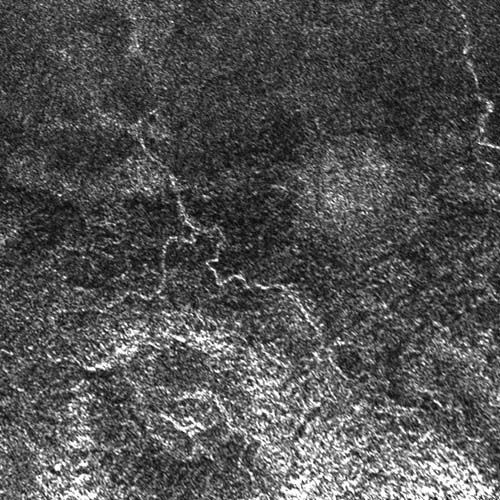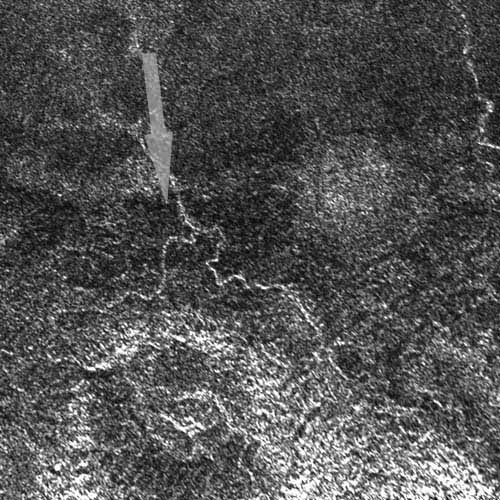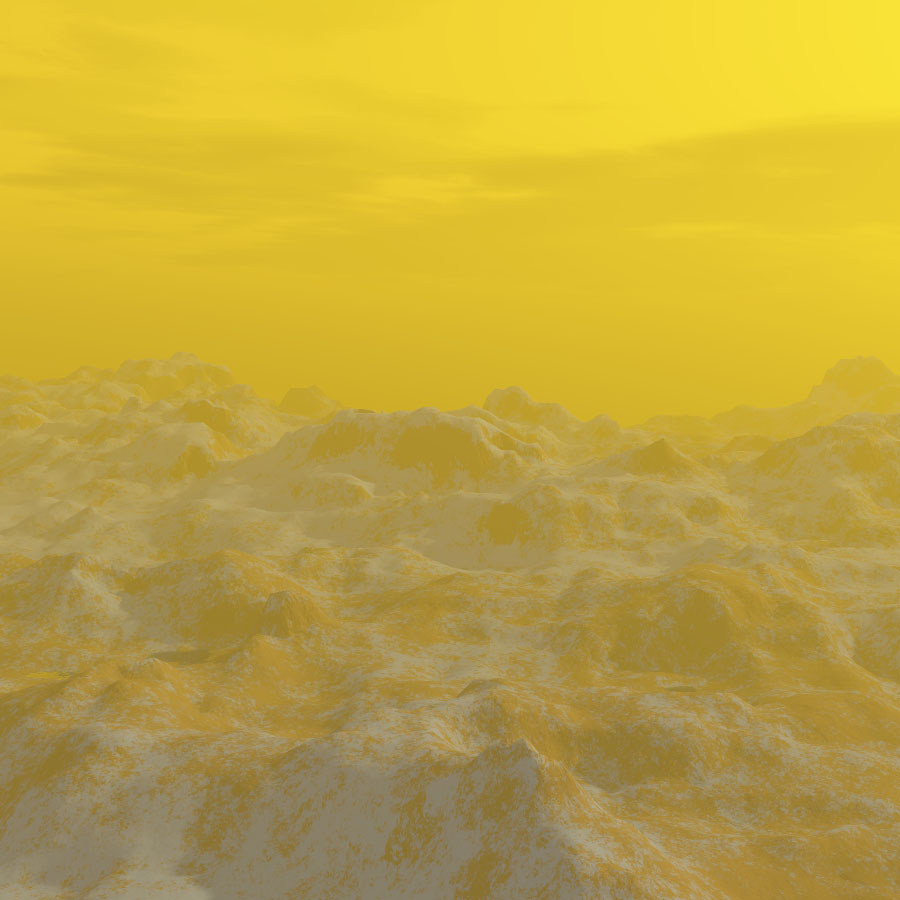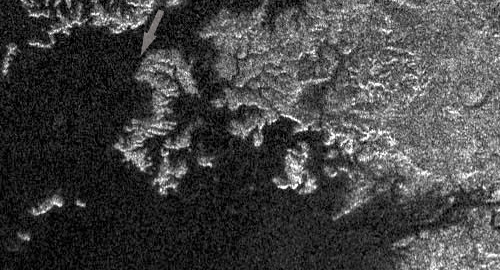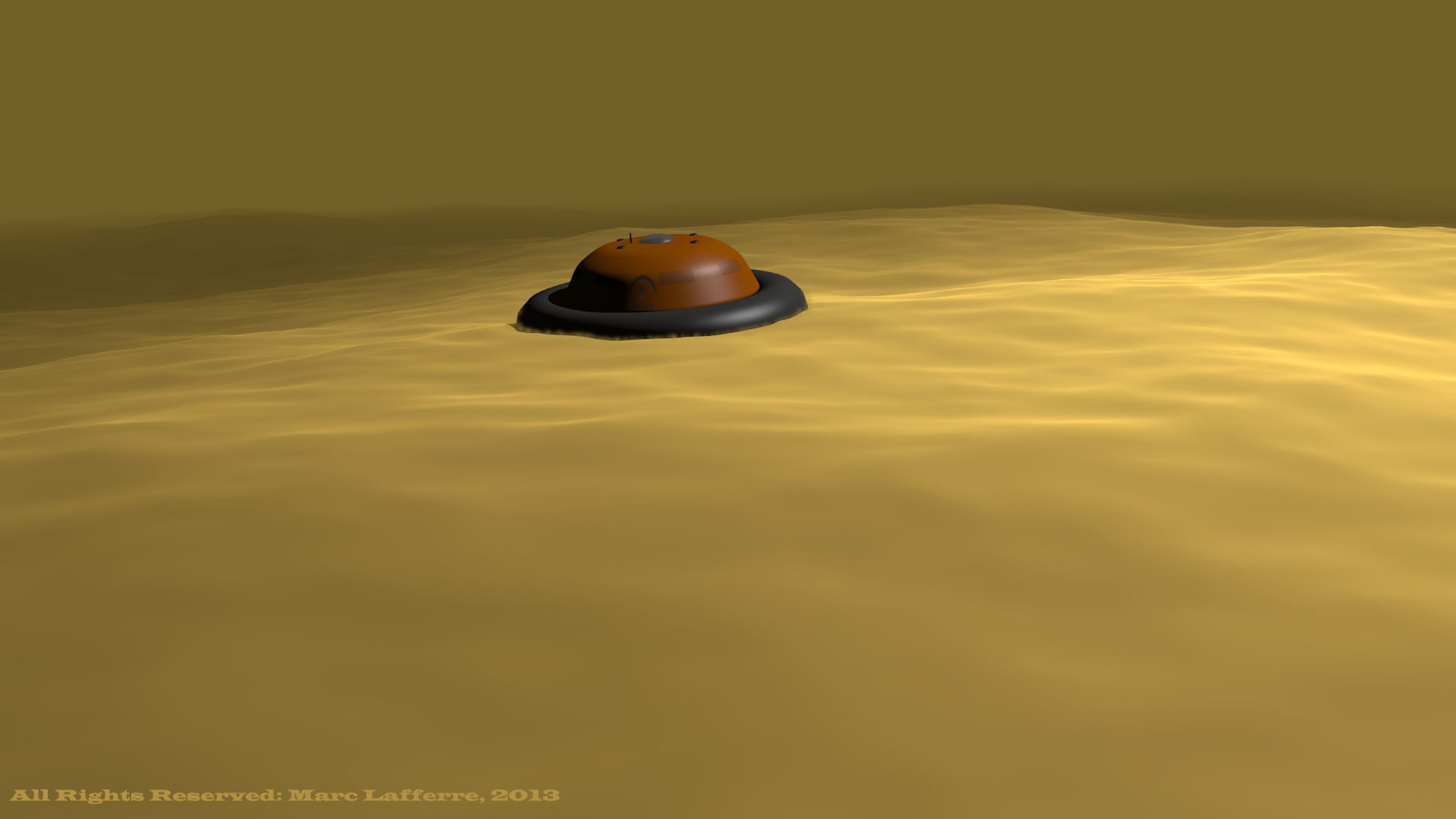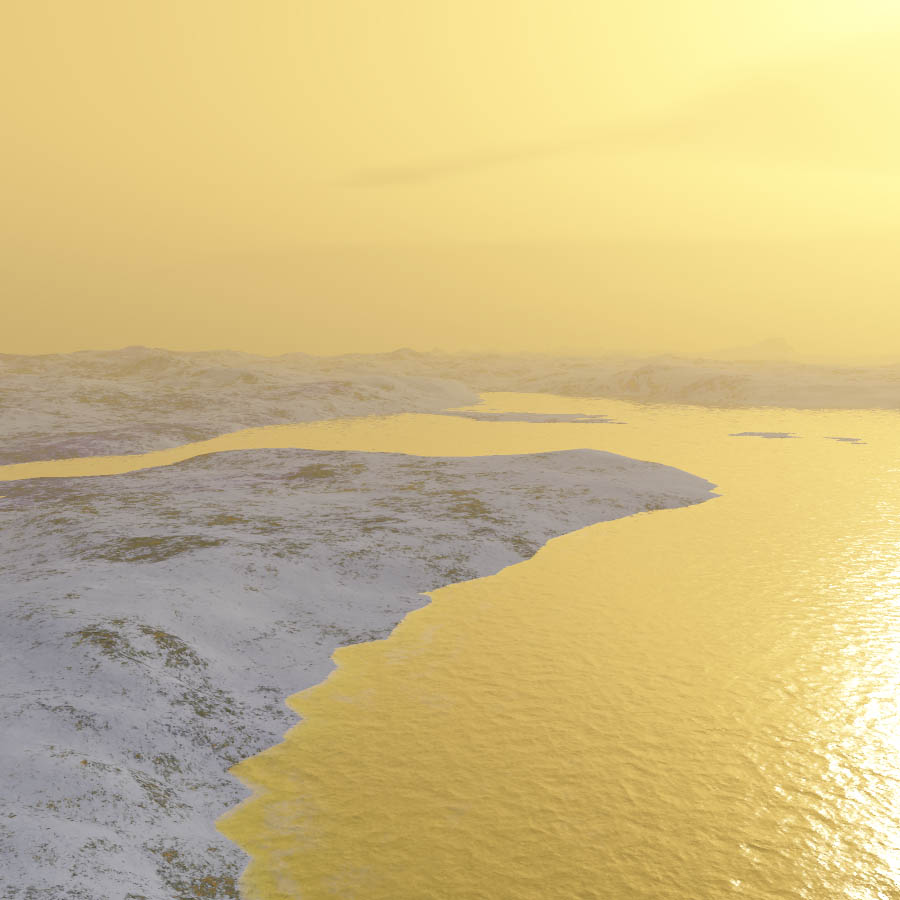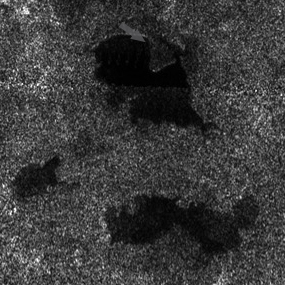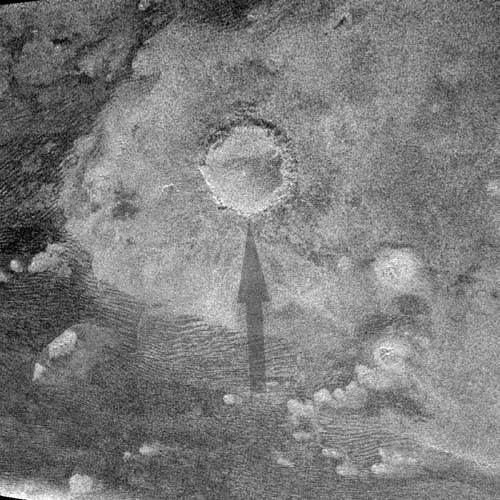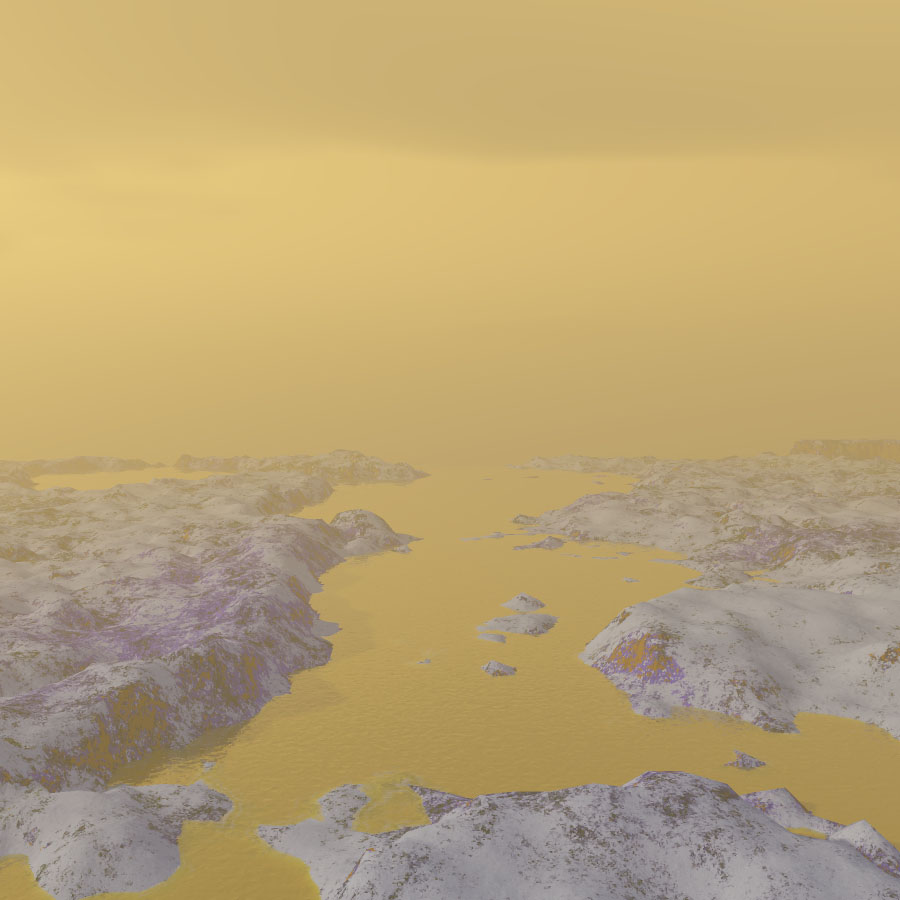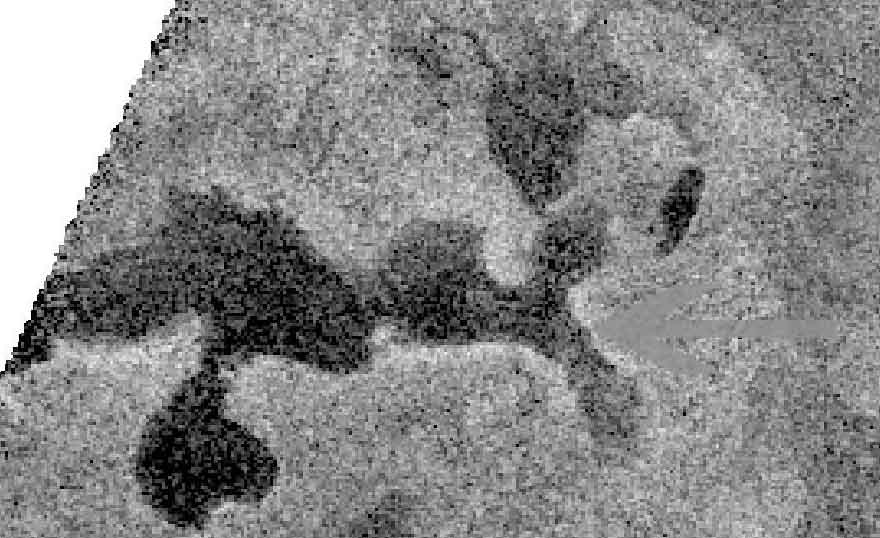Titan News 2013
December 14, 2013: Cassini Data Suggest that Some North Polar Seas or Lakes on Titan Appear Particularly Smooth, Deep and Concentrated Geographically and Appear Dominated by Liquid Methane
The most complete north polar region image of Titan has just been released. The view represents a colorized mosaic of the area based on radar data acquired by the Radar Mapper of the Cassini probe from 2004 to 2013.
The blue or black areas represent the seas, lakes or rivers whereas the yellow or white areas represent icy areas, dry areas or simply the land. The lakes, seas or rivers found in the high latitudes of the northern hemisphere appear to be dominated by liquid methane. Methane and ethane may be the key ingredients of the bodies of liquids in the north polar region.
The recent close flybys of Titan performed by the Cassini spacecraft have allowed scientists to improve the polar map of the northern hemisphere from 50 degrees north latitude to the north pole. This map clearly shows that most of the bodies of liquids are concentrated in a particular area. This area of the high northern latitudes is mostly composed of Kraken Mare, Ligeia Mare and Punga Mare.
The polar stereographic projection, which has just been released, is the most detailed multi-image mosaic of the north polar region to date. The map is composed of several radar images and a haze was incorporated into the map to simulate the Titanian atmosphere. The three well-known seas or lakes, Kraken Mare, Ligeia Mare and Punga Mare appear here and most of the major lakes can be clearly identified.
During some of the flybys, some north polar areas have been imaged from the Cassini probe at a different angle allowing scientists to produce 3D views of some areas. That was the case for the area of Kraken Mare and Ligeia Mare and for some of the nearby lakes. Thus, scientists have been able to generate a flyover of the region around the major seas or lakes Kraken Mare and Ligeia Mare, revealing the smoothness of the seas or lakes as well as mountains or hills.
Steve Wall, acting radar team lead at NASA's Jet Propulsion Laboratory in Pasadena, California pointed out: "Learning about surface features like lakes and seas helps us to understand how Titan's liquids, solids and gases interact to make it so Earth-like."..."While these two worlds aren't exactly the same, it shows us more and more Earth-like processes as we get new views."
The radar view clearly shows, in particular, that the largest body of liquids, Kraken Mare, is more extensive and complex than previously believed. A topographic rupture can be well identified in the lower part of Kraken Mare. It turns out that almost all of the lakes and seas on the Orange Moon are found in an area covering approximately 600 miles by 1,100 miles or 900 kilometers by 1,800 kilometers. It appears that only 3 percent of the liquid on the surface of the Opaque Moon is located outside of this area.
Researchers are trying to determine the geologic processes that led to the formation of lakes and seas in this uncommon area. A deformation of the crust may have engendered topographic depressions or fractures allowing the development of the seas or lakes.
Randolph Kirk, a Cassini radar team member at the U.S. Geological Survey in Flagstaff, Arizona pointed out: "Scientists have been wondering why Titan's lakes are where they are. These images show us that the bedrock and geology must be creating a particularly inviting environment for lakes in this box." He argued: "We think it may be something like the formation of the prehistoric lake called Lake Lahontan near Lake Tahoe in Nevada and California, where deformation of the crust created fissures that could be filled up with liquid."
The seas or the big lakes located in the high latitudes of the northern hemisphere appear dark and particularly uniform because they appear to be particularly smooth and because they appear to be relatively deep. In the colorized mosaic, the major bodies of liquids appear light blue or dark blue depending on the way the radar signal bounced off the ground.
The researchers were able to determine, on the basis of an innovative application of a method previously used to analyze data of the Red Planet Mars, that Ligeia Mare is approximately 560 feet or 170 meters deep. That's a breakthrough since this is the first time researchers have been able to scan the bottom of a lake or sea on the Orange Moon.
This breakthrough was made possible thanks, partly, to the fact that the liquid of the giant lake appears to be very pure, making it easier for the radar signal to go through the liquid and to reach the bottom of the body of liquid. The radar data obtained with the Radar Mapper of the Cassini probe also suggest that the surface of the lakes or seas is extremely smooth and so smooth that it may be as smooth as the paint on our cars.
Scientists had not been able to determine the exact composition of the north polar lakes or seas but the bodies of liquids seem to be composed of a mixture of methane and ethane and the new outcome reveals that the liquid is mostly composed of methane, a simple hydrocarbon compound composed of one carbon atom and of 4 hydrogen atoms. Methane appears as a gas on our planet. Methane is well known as a natural gas.
Marco Mastrogiuseppe, a Cassini radar team associate at Sapienza University of Rome argued: "Ligeia Mare turned out to be just the right depth for radar to detect a signal back from the sea floor, which is a signal we didn't think we'd be able to get." He pointed out: "The measurement we made shows Ligeia to be deeper in at least one place than the average depth of Lake Michigan."
There may be a meteorological cycle involving methane on Titan. That meteorological cycle implies that there are precipitations as well as evaporation processes. The large amount of liquid methane on the surface of the north polar region may also be related to internal sources. Are there reservoirs of liquid methane beneath the icy crust of the high latitudes of the northern hemisphere ? Are there geysers of methane or cryovolcanoes spewing methane ?
On the basis of the data on the depth of the major lakes or seas, Cassini researchers are now in a position to calculate the estimated total volume of the liquids on the Opaque Moon. The study of Marco Mastrogiuseppe enabled Alexander Hayes, of Cornell University in Ithaca, New York, to calculate that there are approximately 2,000 cubic miles or 9000 cubic kilometers of liquid hydrocarbon which represents, approximately, 40 times more than in all the proven oil reservoirs on our planet.
The major lakes or seas of the northern hemisphere were first identified during the Winter period in the northern hemisphere a few years ago. Some researchers believe that the lakes and seas may be a little deeper during the Winter period because there are less evaporation processes during the period in which the area is plunged into darkness.
The north polar area is now experiencing the Spring Season and the Summer season is approaching. Some large cloud formations may start to develop in the area as the solar radiation increases and the evaporation processes rise. Let's be patient and let's see what happens in the coming years in this particular area.
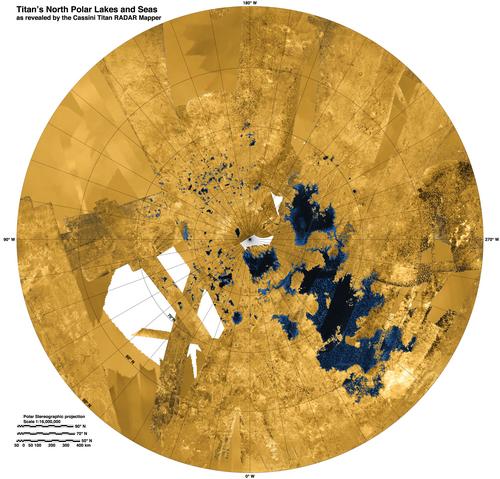
The colorized image above corresponds to an updated mosaic of the north polar region of Titan from 50 degrees north latitude to the north pole. The disc was constructed on the basis of radar images obtained with the Radar Mapper of the Cassini probe from 2004 to 2013. One can clearly notice that the surface liquids are mainly concentrated in the area of Kraken Mare, Ligeia Mare and Punga Mare. The main lakes or seas appear to be particularly deep as the uniform, dark blue tint in some portions of the lakes or seas suggests. The data gathered from the Cassini probe also suggest that the surface of the liquids is extremely smooth. We are far from the Big Wave Theory some scientists had developed at the beginning of the Cassini mission. Image Credit: NASA/JPL-Caltech/ASI/USGS.
- To get more information on that news, go to: http://saturn.jpl.nasa.gov/news/newsreleases/newsrelease20131212.
October 28, 2013: New Near-Infrared Views Clearly Reveal Bright Areas Around Titan's North Polar Lakes and Seas
Thanks to radar data and VIMS data, we know, now, that the lakes, seas and rivers on Titan are mainly concentrated in the high latitudes of each hemisphere. The equatorial and tropical regions appear particularly dry since no clear sign of lake or sea has been identified yet in the low latitudes and since the dark areas of the low latitudes such as Fensal/Aztlan or Shangri-La are dominated by Seif Dunes or linear and parallel dunes extending over long distances.
The north polar region of Saturn's largest moon appears to be the dampest area in the globe with a myriad of lakes, seas and rivers. Kraken Mare is the largest body of surface liquids in the high latitudes of the northern hemisphere. Ligeia Mare appears to be the second largest pool of liquids since it is approximately 300 miles or 500 kilometers across. Punga Mare is a little smaller than Ligeia Mare since it is approximately 240 miles or 380 kilometers across.
The exact nature of the liquids present in the lakes, seas and rivers is still unknown but the lakes, seas and rivers may be mainly composed of a mixture of liquid ethane and liquid methane. Water can't appear in its liquid form on the surface of Titan due to the fact that the environmental temperature is extremely low. Water may be widespread on Titan, in its solid form only.
When the Cassini/Huygens probe arrived into the Saturn System in mid-2004, the north polar region was hidden in the darkness of the Winter season but today, the Winter season is far behind us and the Summer season of the northern hemisphere is approaching. That implies that the solar radiations reaching the north polar region will be stronger and stronger as the Summer period approaches and develops in the area.
Now that the north polar region is well exposed to sunlight, the Visual and Infrared Mapping Spectrometer of the Cassini spacecraft can provide us with quality near-infrared images of the area. The Radar Mapper of the Cassini probe had allowed us to clearly identify the north polar lakes, seas and rivers a few years ago, during the Winter period of the northern hemisphere. Now, scientists are going to be able to combine near-infrared data and radar data to better understand the geologic features in the area, the nature of the soil, the origin of the lakes, seas and rivers and their dynamics.
Three recent flybys of Titan have allowed scientists to get high-quality near-infrared data regarding the north polar area thanks, in particular, to a better viewing geometry than in the past. The Visual and Infrared Mapping Spectrometer and the Imaging Science Subsystem of the Cassini probe had only been able to acquire distant, oblique or partial images of the north polar area in the past.
Scientists can also benefit, now, from the fact that the thick cap of haze which had been observed engulfing the north polar region a few years ago has dissipated as the Summer season in the northern hemisphere approaches. The north polar area has apparently been free of clouds, storms or rainfalls during the recent flybys which helps researchers better identify landscape features.
Some mosaics showing the north polar area and based on near-infrared data obtained from the Visual and Infrared Mapping Spectrometer of the Cassini probe during the Titan flybys of July 10, July 26 and September 12, 2013 clearly reveal some high latitude lakes and seas of the north polar region as well as some intriguing bright areas around the pools of liquids. Researchers believe that the lakes and seas and the bright areas surrounding most of the pools of liquids may be closely related.
Several hypotheses have been put forward. The bright areas may correspond to evaporite and the evaporated compounds may be organic chemicals which may have resulted from the haze and which may have dissolved in the liquid composed of methane in particular. Some lakes and seas may have partially evaporated and the remnant of the lakes may be similar to the Terrestrial salt flats.
One of the mosaics shows the disc of Titan with false colors to help us interpret the nature of the different landscape features. The orange areas which appear against the greenish backdrop of the typical bedrock of water ice may represent the organic chemicals resulting from the evaporation processes.
Jason Barnes who is a participating researcher for the instrument at the University of Idaho, Moscow pointed out: "The view from Cassini's visual and infrared mapping spectrometer gives us a holistic view of an area that we'd only seen in bits and pieces before and at a lower resolution."... He added: "It turns out that Titan's north pole is even more interesting than we thought, with a complex interplay of liquids in lakes and seas and deposits left from the evaporation of past lakes and seas."
The bright deposits or areas observed around the north polar lakes and seas push us into advancing the hypothesis of active cryovolcanism in the north polar area. The lakes and seas may have appeared from the collapse of the icy crust following a cryovolcanic eruption. The bright areas around the pools of liquids may be composed of pure icy material expelled from the hypothetical cryovolcanoes.
The area of the lakes may be composed of a karst terrain in which liquids can dissolve soluble bedrock. That implies that there may be caves and subsurface networks of rivers and lakes. There may be similarities with the karst terrains that we encounter on Earth, in Calern in the south east of France or in New Mexico with the Carlsbad Caverns for instance.
One can notice the particular shape of some lakes with rounded-cutter silhouettes and steep sides. Those observations can help us better understand the formation mechanisms of the lakes and seas. Does Ontario Lacus, the famous sea of the south polar region, have a different origin from the north polar lakes and seas on Titan ? It is too early to say!
Elizabeth (Zibi) Turtle who is a Cassini imaging team associate based at the Johns Hopkins Applied Physics Laboratory, Laurel, Maryland advanced: "Ever since the lakes and seas were discovered, we've been wondering why they're concentrated at high northern latitudes."... "So, seeing that there's something special about the surface in this region is a big clue to help narrow down the possible explanations."
Meteorology with evaporation processes of methane and ethane as well as rainfall may play a key role in the dynamics and in the development of the north polar lakes and seas but scientists need time and data to better understand the dynamics of the north polar lakes and seas and of the meteorology in the area. The problem is that each season is roughly 7 Terrestrial years long and a Titanian year is almost 30 Terrestrial years long.
Linda Spilker, a Cassini project scientist, based at NASA's Jet Propulsion Laboratory, Pasadena, California argued: "Titan's northern lakes region is one of the most Earth-like and intriguing in the solar system." She explained: "We know lakes here change with the seasons, and Cassini's long mission at Saturn gives us the opportunity to watch the seasons change at Titan, too. Now that the sun is shining in the north and we have these wonderful views, we can begin to compare the different data sets and tease out what Titan's lakes are doing near the north pole."
Curiously, the polar regions of Titan seem to be the most dynamic places of the Opaque Moon from a meteorological point of view and from a geological point of view. Is it related to tidal forces like in the south polar region of the bright Enceladus where fractures emit sprays of water ice due mainly to the gravitational interaction with Saturn ?
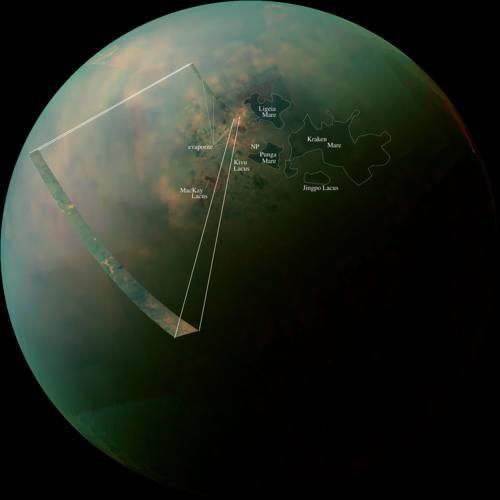
The disc above, corresponding to a false-color mosaic made of infrared data, shows key surface features in the north polar area of Saturn's largest moon Titan. One can notice in particular the dark seas or lakes Kraken Mare, Ligeia Mare and Punga Mare as well as bright or orange areas around most of the lakes. The orange areas may correspond to a bright deposit resulting from cryovolcanic eruptions. The mosaic is based on data taken with the Visual and Infrared Mapping Spectrometer of the Cassini probe during a close flyby of the Orange Moon on September 12, 2013. Image Credit: NASA/JPL-Caltech/University of Arizona/University of Idaho.
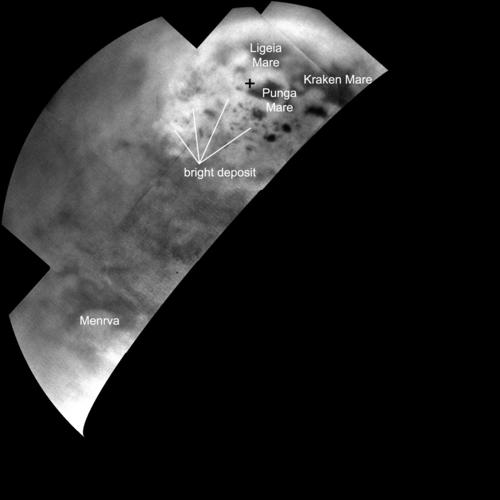
The mosaic above composed of near-infrared images acquired by the Imaging Science Subsystem of the Cassini probe on July 10, 2013 shows key surface features on Titan. On can notice in particular the rounded shape of the impact crater Menrva. Menrva which appears bright is surrounded by a relatively dark area. One can observe that the north polar region is dominated by several dark lakes or seas and that bright areas surround most of the lakes or seas. A black cross indicates the north near the lake Punga Mare. Image Credit: NASA/JPL-Caltech/SSI/JHUAPL/University of Arizona.
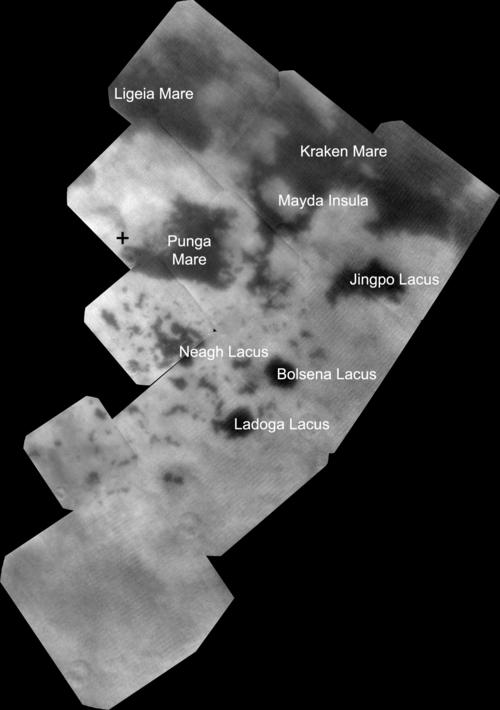
The mosaic above composed of near-infrared images taken by the Imaging Science Subsystem of the Cassini probe on September 12, 2013 unveils a portion of the north polar region. One can notice, in particular, some bright areas surrounding most of the lakes or seas. Only a portion of Kraken Mare, the largest body of surface liquids on Titan, is visible here. A multitude of lakes can be seen here from big ones like Punga Mare or Ligeia Mare to smaller ones like Jingpo Lacus, Bolsena Lacus or Ladoga Lacus. Image Credit: NASA/JPL-Caltech/SSI/JHUAPL/University of Arizona.
- To get more information on that news, go to: http://saturn.jpl.nasa.gov/news/newsreleases/newsrelease20131023.
October 19, 2013: A New Study Shows that the Increase in Solar Activity Boosts the Titanian Ionosphere
A new study led by Niklas Edberg, a post-doctoral researcher at the Swedish Institute of Space Physics in Uppsala, Sweden, entitled "Solar cycle modulation of Titan's ionosphere" and published in the Journal of Geophysical Research: Space Physics, Volume 118, Issue 8 in August 2013 confirms, on the basis of Cassini data, predictions that the density of the Titanian ionosphere is directly related to the 11 year cycle of solar activity.
The in-depth analysis of Cassini data clearly shows that the increase in solar activity engenders a rise in the density of Titan's ionosphere. The ionosphere is a region in the upper atmosphere of any atmosphere which is dominated by ionised particles or electrically charged particles (electrons and ions). The ionospheres mainly take shape from photoionisation of the atmosphere.
This photoionisation of the upper atmosphere is a process which involves X-rays and Extreme Ultraviolet (EUV) radiations from our star. The X-rays and the Extreme Ultraviolet radiations interact with atmospheric molecules to form ions and electrons. When the atmosphere is directly exposed to Sun light, the density of the atmosphere increases via photoionisation. That's why the density of the ionosphere reaches its maximum above the day hemisphere of the moon and is much lower above the night hemisphere.
The Voyager 1 spacecraft was the first probe in November 1980 to observe the ionosphere of Titan on the basis of radio occultation measurements. But today, most of our knowledge about the Titanian ionosphere is related to analyses based on Cassini data. Researchers have had the opportunity to gather an enormous amount of atmospheric data since the arrival of the Cassini probe into the Saturn System in July 2004.
The opaque, orange and deep atmosphere of Saturn's largest moon appears particularly complex and dynamic with a dense, orange haze or smog of organic molecules which hides the icy surface. Nitrogen is by far the most abundant gas in the atmosphere. Methane is the second most abundant compound in the atmosphere.
Of course, the composition of the Titanian atmosphere is not homogeneous from the ground to the upper atmosphere. Thus, the ionosphere appears to be dominated by relatively complex organic molecules such as protonated hydrogen cyanide (HCNH+) and C2H5+ which is an ethyl group. Multiple minor compounds, engendered by the complex interactions of the upper atmosphere can also be found in the ionosphere.
The ionisation process of the atmosphere appears to be mainly due to the Extreme Ultraviolet light from the Sun. The particles or molecules trapped in Saturn's magnetosphere which interact with the upper atmosphere of Titan appear to have limited effects on the development of the dayside ionosphere. But, they have, relatively speaking, a stronger impact on the night side ionosphere.
Scientists have been able to determine that the peak density in the ionosphere is found between 1000 and 1300 km above the ground, with a fall in altitude where the Sun is higher over the horizon. The electron density can range from approximately 1000 particles per cubic cm on the night side to about 3000 particles per cubic cm on the dayside.
Researchers have been in a position to monitor or to study the evolution of the structure and of the density of the ionosphere for a relatively long period of time and they notice significant changes over time. The researchers have been able to draw a strong parallel between the 11 year solar cycle and the evolution of Titan's ionosphere.
The analyses of researchers were based on the Langmuir probe instrument data. The Langmuir probe instrument is part of the radio and plasma wave science instrument of the Cassini spacecraft. It allows us to monitor the density, temperature and bulk speed of plasma or electrons and ions over time.
The researchers of the study have determined that the density of the ionosphere was higher during the recent flybys than during the early stages of the mission. They notice that the level of solar activity was moderate to low at the beginning of the mission and relatively high in the recent flybys. They corrected the measurements for the different flyby geometry and position of the overhead Sun and they inferred a clear correlation between the amount of ionisation in the Titanian ionosphere and the level of solar activity.
Niklas Edberg pointed out: "We found that the varying EUV flux during the solar cycle strongly influenced the peak electron density of Titan's ionosphere." He added: "From the first Titan flyby of the Cassini mission on 26 October 2004 until T71 (the 72nd close pass of Titan) on 7 July 2010, it was not possible to identify any large changes in the structure of the ionosphere in response to either solar cycle changes or seasonal changes in Titan's atmosphere."... "However, after 2010, solar activity picked up rapidly and our analysis showed that, during six Titan flybys between May 2012 and November 2012, the electron density in the ionospheric peak region, as measured by the Langmuir probe on Cassini, increased by 15-30%, compared to the previous average."
As a result, one can deduce a strong correlation between the density of the ionosphere and the level of solar activity. The increase in solar activity has been accompanied by an increase in the density of the Titanian ionosphere. Let's note however that, from 2004 to 2012, the distance between Saturn and its moons and the Sun increased by more than 100 million km because the orbit of Saturn and its moons around the Sun is elliptical. That implies that the Orange Moon receives, in 2012, a smaller percentage of incoming solar radiation than in 2004. Yet, the increase in solar activity has apparently engendered an increase in the density of the ionosphere of Titan.
Niklas Edberg argued: "The ionospheric peak electron densities during the more recent Titan flybys are significantly increased compared to measurements from previous flybys, and the peaks are generally also found at lower altitudes in the ionosphere than previous average values."
The empirical results are in line with the existing theory according to which the production rate of electrons and ions should be proportional to the square root of the ionising radiation increase. The measurements about ionisation densities were performed in a particular period since our period corresponds to the deepest solar minimum since the seventeenth century. Therefore, the peak densities which have been recently measured have been lower than in previous cycles even if we are advancing toward the solar cycle maximum in terms of activity.
The theoretical calculations reveal that the peak electron densities in the Titanian ionosphere could exceed 6500 particles per cubic cm at the subsolar point during periods of higher solar activity, which corresponds to 85-160% more than what has been measured from the Cassini probe as the latest solar cycle attains its peak.
Nicolas Altobelli who is ESA's Cassini project scientist explained: "Nearly the same mechanisms exist at Earth, where the possible long-term effects of solar cycles on Earth's climate evolution are debated." He concluded: "Titan is often referred to as a primitive Earth in deep freeze, so it is fascinating to compare the physical processes taking place in the upper atmospheres of these two worlds."
We know, now, that Titan's atmosphere engenders complex organic molecules under the action of ultraviolet light. Recently, some researchers have announced the finding of the building blocks of a common household plastic in the Titanian atmosphere that is to say propylene. Scientists will continue to look for more complex organic molecules on the ground or in the atmosphere. Will we ever find amino acids, proteins or lifeforms on Titan ? Is Titan really a prebiotic natural laboratory ?
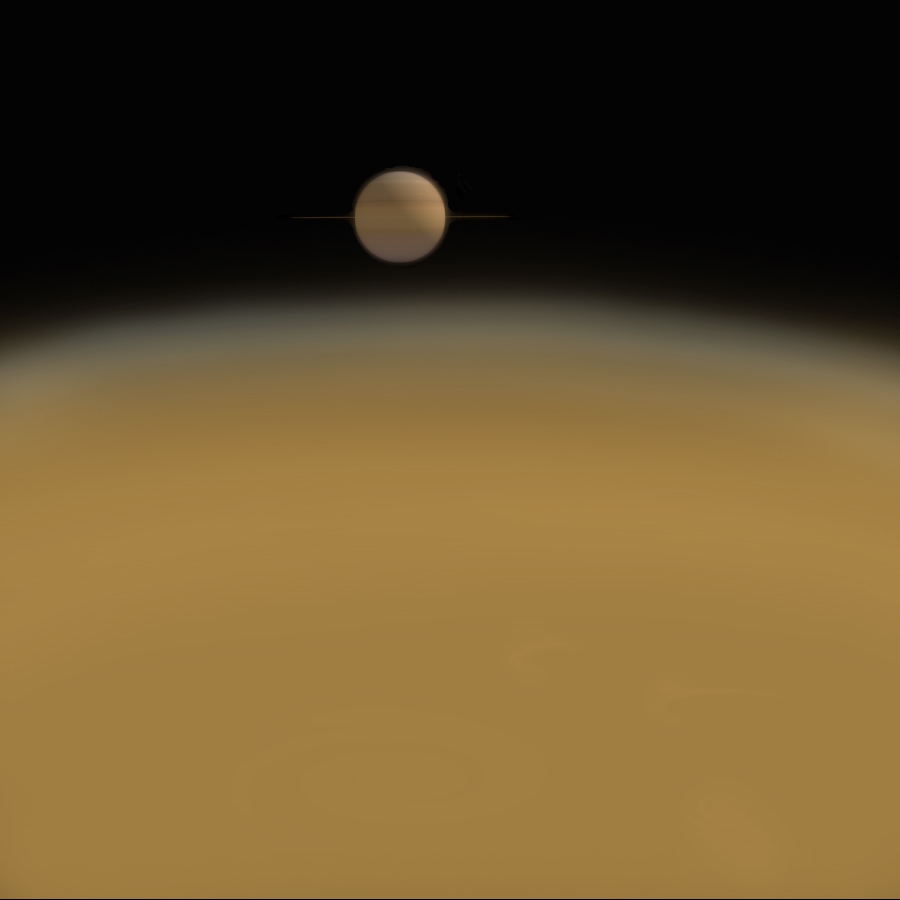
The artistic view above shows the atmosphere of Saturn's largest moon Titan in the foreground and Saturn in the background. The rings of Saturn appear nearly edge-on since the orbit of Titan is roughly on the same plane as the rings of Saturn. In this simulated view, the field of view is 57 degrees horizontally, the virtual camera is located approximately 1,216 km from Titan and approximately1,223,086 km from the Gas Giant Saturn. The diameter of Titan is about 5,150 km whereas the diameter of Saturn is about 120,536 km. Titan orbits Saturn at a mean distance of 1,221,870 km. The ultraviolet light plays a key role in the chemistry of the upper atmosphere. The density of the ionosphere is higher when it is exposed to sunlight. In other words, the ionosphere is more massive when it is exposed to day light or UV light from the Sun than when it is hidden from the Sun in the night side. Image Source: Marc Lafferre, 2013.
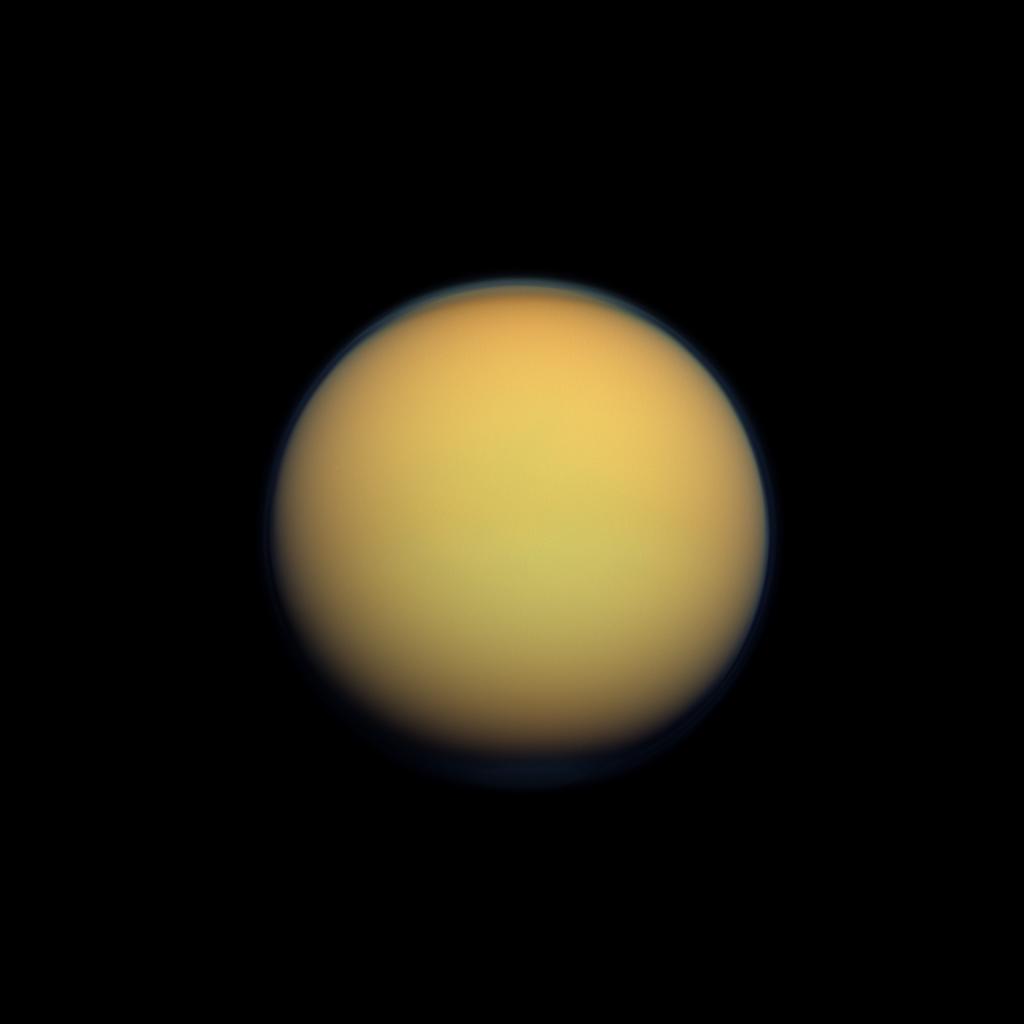
The natural color view above, acquired with the Wide-Angle Camera of the Cassini spacecraft on January 30, 2012, shows the orange and opaque disc of Saturn's largest moon Titan. The natural color image is the outcome of the combination of images obtained using red, green and blue spectral filters. In this view, Titan is moving at a distance of about 119,000 miles or 191,000 kilometers from the Cassini probe. One can notice the north polar hood as well as the blue haze layer at the boundaries of the atmosphere. Several significant seasonal changes have been observed in the atmosphere of the Opaque Moon. Image Credit: NASA/JPL-Caltech/Space Science Institute.
- To get further information on that news, go to: http://sci.esa.int/cassini-huygens/53074-the-active-sun-boosts-titan-outer-atmosphere or http://www.spacedaily.com/reports/The_active_Sun_boosts_Titans_outer_atmosphere_999.html.
October 3, 2013: The Cassini Spacecraft Identifies a Building Block of Household Plastic in Titan's Atmosphere
Saturn's largest moon Titan continues to surprise us with its complex atmosphere, its varied landscape, its rivers, its lakes or seas. The opaque atmosphere of Titan is made of a strange and complex haze and shows a pleiade of organic chemicals.
The atmosphere of Titan reveals some similarities with the atmosphere of the Earth. Both atmospheres are primarily composed of molecular nitrogen. The second most abundant gas in the atmosphere of the Orange Moon is methane. The concentration of methane can reach up to 5% of the composition in the Troposphere.
Scientists have identified a multitude of hydrocarbons or organics in the Titanian atmosphere. A new study reveals the identification of a surprising type of organic molecules in the atmosphere, propylene. Propylene is in fact an ingredient or a building block of a familiar plastic known as Polypropylene. Propylene is widely used to produce food-storage containers, car bumpers and other consumer products. Let's note that Ethylene is also used to produce the plastic known as Polyethylene Terephthalate or PET.
The study upon the identification of propylene in Titan's atmosphere, led by Conor Nixon, a planetary scientist at NASA's Goddard Space Flight Center in Greenbelt, Maryland was presented in a paper in the September 30 edition of the Astrophysical Journal Letters.
Propylene had never been clearly identified on any other moon or planet, other than Earth. The finding was made possible thanks to the Composite Infrared Spectrometer or CIRS of the Cassini probe which measures the infrared radiation, or heat radiation, emitted from any planet or moon.
The CIRS detected a small amount of propylene in the lower atmosphere of the Orange Moon. The researchers inferred the presence of the hydrocarbon with a high degree of confidence by isolating the same signal at different altitudes within the lower atmosphere.
Scientists determine the composition of any gas blanket on the basis of the unique thermal fingerprint of gases. The researchers have to attempt to isolate the signature of any gas from the signals of all other compounds around it.
Titan could be compared to a factory producing organics, from simple hydrocarbons formed by one carbon atom to more complex hydrocarbons formed by several carbon atoms. Propylene is composed of three carbon atoms and six hydrogen atoms and it can be regarded as a complex hydrocarbon.
Conor Nixon pointed out: "This chemical is all around us in everyday life, strung together in long chains to form a plastic called polypropylene."... He added: "That plastic container at the grocery store with the recycling code 5 on the bottom-- that's polypropylene."
Surprisingly, NASA's Voyager 1 probe, which had performed the first-ever close flyby of Saturn's largest moon in 1980, had detected the heaviest molecule of the three-carbon hydrocarbon that is to say propane and propyne, one of the lightest members but it hadn't identified the middle weight organics of the family such as propylene.
The new finding demonstrates that the hazy brownish atmosphere of Titan can produce any hydrocarbon, from the lightest hydrocarbons such as methane or ethane to heavier hydrocarbons such as propane or butane which can fall to the surface. The upper atmosphere of Titan is an area of complex chemical interactions involving sunlight and particularly ultraviolet light.
Methane, which is composed of one carbon atom and 4 hydrogen atoms, can be broken apart under the action of ultraviolet radiations. The new molecules, radicals or atoms can then recombine to form new molecules, from simple molecules to complex molecules composed of three or more carbon atoms.
Methane, ethane and propane seem to be key elements of Titan's meteorology. Ethane is a saturated hydrocarbon with the chemical formula C2H6 and it is a flammable gas on Earth. Propane is a more complex saturated hydrocarbon with the chemical formula C3H8 and it is a common fuel for portable stoves.
We now know that we can encounter propane, propylene and propyne in the Titanian atmosphere. Thus, the atmosphere of Titan contains some ingredients of household plastic. Our plastic is widely produced on the basis of petroleum and other fossil fuels. On Titan, the hydrocarbons are in the air or on the ground.
The finding of propylene in the Titanian atmosphere is the outcome of in-depth analyses based on ground-and-space-based instruments such as the CIRS instrument which allowed researchers to isolate propylene, the primary ingredient of the chains of propylene known as polypropylene.
Michael Flasar, Goddard scientist and principal investigator for CIRS argued: "This measurement was very difficult to make because propylene's weak signature is crowded by related chemicals with much stronger signals."... "This success boosts our confidence that we will find still more chemicals long hidden in Titan's atmosphere."
The mass spectrometer of the Cassini probe, which can identify the composition of the Titanian atmosphere, had suggested earlier the potential presence of propylene in the upper atmosphere but no positive identification had been performed.
Scott Edgington, Cassini's deputy project scientist at NASA's Jet Propulsion Laboratory in Pasadena, California, pointed out: "I am always excited when scientists discover a molecule that has never been observed before in an atmosphere." He advanced: "This new piece of the puzzle will provide an additional test of how well we understand the chemical zoo that makes up Titan's atmosphere."
The complex organic chemistry taking shape on Titan may help us understand the complex molecular interactions that led to life on Earth or to the formation of proteins or amino acids.
The exact nature of the rivers, lakes or seas on Titan is still unknown but the liquids may be composed of mixtures of methane, ethane and propane and propylene, which can appear in its liquid form in the harsh environment of Titan, may be part of the hypothetical mixture. If the liquid is composed of several organic chemicals or hydrocarbons, it may be quite viscous and dark like the liquid in the oil pits one encounters on Earth.
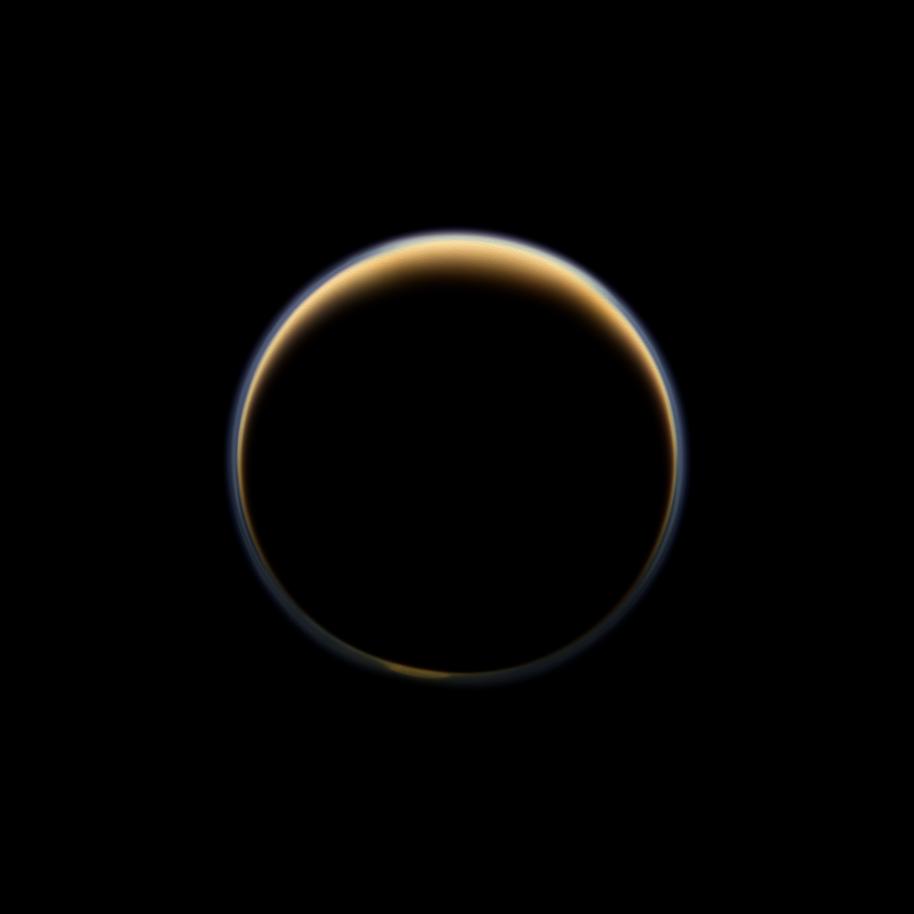
The image above corresponds to a natural color view of Titan's disc obtained with the Wide-Angle Camera of the Cassini probe on June 6, 2012. The moon can be seen, here, at a distance of about 134,000 miles or 216,000 kilometers. One can clearly notice the blue tint of the upper atmosphere as well as the famous yellow south polar vortex in the lower part of the disc. Ultraviolet light from the Sun interacts with molecules of the upper atmosphere to engender new molecules such as propane, propylene (propene) or propyne. Image Credit: NASA/JPL-Caltech/SSI.
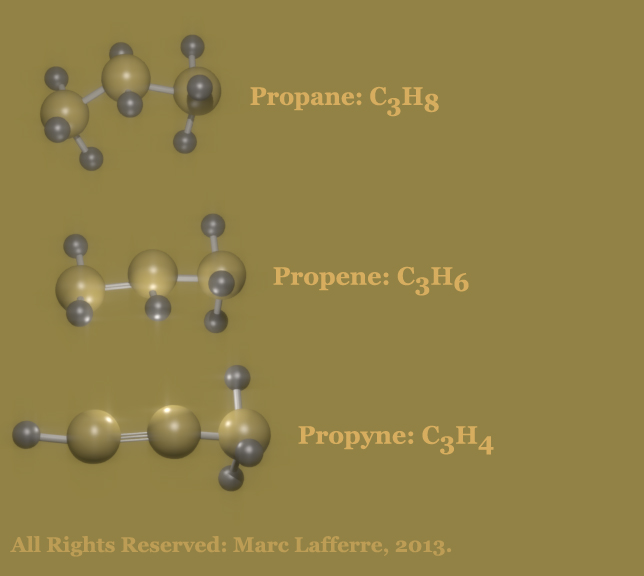
The illustration above shows three different hydrocarbon molecules composed of three carbon atoms. The yellow spheres represent carbon atoms whereas the grey spheres represent hydrogen atoms. Each carbon atom can generate four connections. Propane, propene and propyne have been clearly identified in the atmosphere of Titan and propene, also known as propylene, is part of a common family of plastic produced on our planet. Image Credit: Marc Lafferre, 2013.
- To get further information on that news, go to: http://saturn.jpl.nasa.gov/news/newsreleases/newsrelease20130930.
September 26, 2013: Changes in Surface Brightness on Titan Imply the Possibility of Active Cryovolcanism
Is there an active cryovolcanic activity on Saturn's largest moon Titan ? That's one of the major questions planetologists have been trying to answer. Some clues gathered by scientists over a four year period, on the basis of the Visual and Infrared Mapping Spectrometer and the Radar Mapper of the Cassini probe suggest the presence of active cryovolcanoes at least in the low latitudes of the moon.
A team led by Anezina Solomonidou, of the Observatoire de Paris and National and Kapodistrian University of Athens, performed a study on signs of active cryovolcanism on the Orange Moon. The researchers note changes in surface brightness in some areas and they relate them to a potential cryovolcanism. The albedo changes were identified between 2005 and 2009.
Anezina Solomonidou has presented the outcome of the study at the European Planetary Science Congress (EPSC) 2013 in London. Tui Regio, Hotei Regio and Sotra Patera are regions or landscape features which appear to be key candidates for active cryovolcanism.
Anezina Solomonidou and her team compared those geological features with landscape features on the Earth which have a similar appearance. Some landscape or topographic features on Titan are reminiscent of volcanoes, volcanic flows, drainage channels, rivers, calderas and craters. The researchers conclude that active cryovolcanoes may lie within regions close to the equator of the Opaque Moon.
The study of Titan's landscape is not easy because of Titan's veil which is completely opaque in the visible spectrum. The landscape features can be well discerned in the near-infrared spectrum thanks to the Visual and Infrared Mapping Spectrometer of the Cassini spacecraft.
The Radar Mapper of the probe has allowed us to clearly identify Seif dunes extending over long distances in the low latitudes of the moon. The Huygens probe which landed in the Adiri/Shangri-La region on January 14, 2005 revealed bright hills with topographic fractures or drainage channels. Are the channels or fractures related to an internal activity ?
The surprisingly high proportion of methane in Titan's deep, thick and opaque atmosphere has pushed scientists into advancing the hypothesis of internal sources, geysers of methane and ethane and active cryovolcanoes.
The atmosphere of Titan is complex with a strange haze and with a large amount of organics, hydrocarbons or carbon-based compounds. Some dynamic cloud systems have been noticed in the high latitudes or in the polar regions of the moon.
The Radar Mapper of the Cassini probe has allowed us to clearly identify seas, lakes or rivers in the polar regions. That's a sign that there is a meteorological cycle involving evaporation processes, cloud formation and rain. Methane and ethane may play a key role in this enigmatic meteorological cycle. A parallel could be drawn between the water cycle on Earth and the methane or ethane cycle on Titan.
The winds, the rain or the snow appear to engender strong erosional processes. Some planetologists advance that there may be an underground ocean of liquid water probably mixed with ammonia beneath the icy crust of the Orange Moon. That may imply crustal displacements, fractures, a tectonic activity, geysers or cryovolcanoes.
The hypothesis for active cryovolcanoes is strengthened by the fact that the number of impact craters identified on Titan is particularly low. That implies that the surface is relatively young and dynamic. Weathering and cryovolcanism can account for those observations.
Anezina Solomonidou pointed out: "All of these features, plus a need for a methane reservoir and volcanic activity to replenish the methane we have detected in the atmosphere, is compatible with the theory of active cryovolcanism on Titan."
The team of Anezina Solomonidou focused its attention on three potential icy volcanoes or volcanic regions, Tui Regio, Hotei Regio and Sotra Patera on the basis of the Visual and Infrared Mapping Spectrometer data.
Tui Regio and Hotei Regio can be found in the optically bright region of Xanadu. Tui Regio, which is approximately 1,200 km long, is centered at about 24.5 degrees south latitude and 124.9 degrees west longitude. Hotei Regio, which is approximately 500 km long, is centered at about 26 degrees south latitude and 78 degrees west longitude. Sotra Patera, which is about 40 km long, is centered at approximately 14.54 degrees south latitude and 40 degrees west longitude.
Any region whose brightness increases over time can suggest the presence of an active cryovolcano which has recently spewed water ice or which is spewing water ice. Anezina Solomonidou argued: "We were able to penetrate the atmosphere with VIMS and view any changes in these surface features. Interestingly, the abedo (brightness) of two of the areas has changed with time."..."Tui Regio got darker from 2005 to 2009 and Sotra Patera -- the most favorable cryovolcanic candidate on Titan -- got brighter between 2005 and 2006."
Strong rainfalls or snowfalls can wash the landscape and make the soil brighter. The materials or the volatiles expelled by an hypothetical cryovolcano can also make the soil brighter. Sotra Patera looks like a volcano with a deep crater and a significantly high mountain. The crater may be a volcanic caldera. A parallel was drawn between Sotra Patera and Kirishima volcano in Japan.
The reflectivity of the surface, the changes in albedo and the presence of volcanic-like features bring significant clues for the cryovolcanic hypothesis and for an underground network between the soil and an internal ocean of liquid water mixed with ammonia.
Anezina Solomonidou concluded: "These results have important implications for Titan's potential to support life as these cryovolcanic areas might contain environments that could harbor conditions favorable for life."
The hypothesis of a water-based lifeform around hydrothermal vents inside the hypothetical subsurface ocean of liquid water is not ruled out. Sotra Patera may be a perfect exploration place for a study of the underground and to search for lifeforms.
|
|
|
|
| The image in the upper part of the table corresponds to
a portion of the radar swath obtained with the Radar Mapper of the
Cassini probe during the T41 flyby of the Orange Moon Titan, on February
22, 2008. The view shows the Hotei Arcus region. Several bright sinuous
channels can be clearly identified in the view. The bright channels may
be related to an ancient meteoritic impact or to cryovolcanism. A bright
topographic ring suggests the presence of a caldera or of an impact crater.
The bright channels seem to be drainage channels finding their sources
in the mountains or hills rather than topographic fractures resulting
from an unstable crust. The image in the lower part of the table represents an artistic view of the area. The artist's impression is based on radar data from the top view. The grey arrow in the second image from the top of the table, incorporated by Marc Lafferre into the original radar image, shows the orientation of the virtual camera revealing the artistic image of Hotei Arcus. Radar Image Source, Top View:
NASA,/JPL/Cassini Radar Team. |
- To get further information on that news, go to: http://www.astrobio.net/pressrelease/5694/changes-in-titans-surface-brightness-point-to-cryovolcanism or http://www.europlanet-eu.org/epsc2013/media-press/epsc-2013-press-releases/76-epsc2013/media-press/626-changes-in-titan-s-surface-brightness-point-to-cryovolcanism.
September 19, 2013: The Organics Found on Titan May Interact to Form More and More Complex Molecules Over Time
Titan appears to be one of the most enigmatic worlds in the Solar System. The surface of this moon of Saturn is hidden beneath a thick, deep and opaque atmosphere. The atmosphere of this giant moon may resemble the atmosphere of the Early Earth.
Nitrogen is by far the most abundant element of the atmosphere of Titan and the Earth. There is no significant amount of oxygen in the Titanian atmosphere as opposed to the Terrestrial atmosphere. The second most abundant gas of Titan's atmosphere appears to be methane.
Near-infrared data from the Visual and Infrared Mapping Spectrometer of the Cassini probe as well as radar data from the Radar Mapper of the Cassini probe have revealed familiar meteorological phenomena, lakes, rivers, mountains and even dune fields. The surface of Titan may be full of hydrocarbons and organics.
The seas, lakes or rivers identified in the north polar region and in the south polar region may be mostly composed of methane and ethane. The soil of Titan may harbor the same types of organics that were present on our planet more than 3.5 billion years ago a little before Terrestrial life started to develop.
That's a point of view championed by Jonathan Lunine, Ph.D, who is with Cornell University and who is involved with the Cassini-Huygens mission with about 260 other researchers.
Jonathan Lunine developed the idea that the Orange Moon is providing insights into the evolution of Terrestrial life, in a talk at the 246th National Meeting & Exposition of the American Chemical Society (ACS), the largest scientific society worldwide.
It's likely that over time, carbon-based compounds or organics form more and more complex molecules and have the potential to generate lifeforms at a particular stage. This process of complexification is made possible thanks to sunlight and other sources of energy which fuel chemical reactions.
Jonathan Lunine pointed out: "Data sent back to Earth from space missions allow us to test an idea that underpins modern science's portrait of the origin of life on Earth."... He advanced: "We think that simple organic chemicals present on the primordial Earth, influenced by sunlight and other sources of energy, underwent reactions that produced more and more complex chemicals. At some point, they crossed a threshold - developing the ability to reproduce themselves. Could we test this theory in the lab ? These processes have been underway on Titan for billions of years. We don't have a billion years in the lab. We don't even have a thousand years."
Researchers often say that Titan represents a natural prebiotic laboratory. Simple or even complex lifeforms may emerge or thrive in the famous lakes or seas of hydrocarbons found in the high latitudes of Titan. Ontario Lacus, Ligeia Mare, Kraken Mare and Punga Mare appear to be key targets for the future missions towards Titan.
A parallel can be drawn between natural gas and oil found inside the crust of the Earth and the organics and hydrocarbons found on Titan. The hydrocarbons of the Earth mostly result from the decay of ancient living organisms which have been buried and compressed over time.
The organic substances of our planet have been cycled or recycled countless times. By contrast, the organic materials found on the Orange Moon are in pristine condition. They are not generated by Titanian lifeforms.
The origin of methane on Titan is not well understood because it tends to disappear over a geological time scale. There may be internal sources via cryovolcanism or geysers. The ultraviolet light from the Sun plays a key role in the chemistry of the upper atmosphere.
The hydrocarbons such as methane present in the upper atmosphere can break up and form new molecules under the action of ultraviolet light. Chemical reactions occur between methane, ethane, nitrogen or radicals to form new molecules such as ethylene, acetylene, hydrogen cyanide, cyanoacetylene, methane and ethane.
Jonathan Lunine argued: "We've got a very good inventory of what's there in the atmosphere."... "What we've only recently begun to understand is the fate of these organics at the surface of Titan."
Currently, researchers tend to focus most of their attention on planetary bodies such as Mars and the Moon. But, there are no lakes, seas or rivers on the surface of these bodies as opposed to Titan which unveils Earth-like phenomena such as cyclones, cloud systems, rainfall, evaporation, lakes, seas and rivers.
Titan undoubtedly deserves more attention. There may be wonderful panoramas or breathtaking landscapes on Titan and the development of a methane-based life is not ruled out on this moon. There may be more complex molecules on Titan than on the Red Planet Mars where, only, simple organic materials have been identified so far.
In the harsh environment of the Opaque Moon where the environmental temperature is around -179 degrees Celsius, -290 degrees Fahrenheit or 94 Kelvin, water can't appear in its liquid form. It can only appear as ice or in its solid form. It can't act as a solvent for the development of any lifeform based on water.
However, some studies suggest that under the icy crust of Titan, a subsurface ocean mainly composed of liquid water may exist. Internal volcanoes may bring the heat and the ingredients necessary for the development of lifeforms similar to the lifeforms we've identified around the seafloor on Earth where hydrothermal vents take shape.
If carbon, hydrogen, oxygen, nitrogen, phosphorus and sulfur are there, life can potentially arise. Icy volcanoes on Titan may be key targets to look for signs of lifeforms coming from the hypothetical internal ocean.
Two different lifeforms may exist on Titan at the same time: a lifeform based on liquid water in the subsurface ocean and a lifeform based on liquid methane or ethane in the high-latitude lakes or seas of the moon.
The low latitudes of the moon may be less interesting, astrobiologically speaking because the dark areas tend to be dominated by Seif Dunes extending over long distances.
If a lifeform exists on Titan, it has to manage a very little amount of energy since the moon only receives approximately 1 percent of the sunlight that the Blue Planet receives.
Titan could make our oil specialists dream since the deposits of hydrocarbons on Titan may be 10 to 100 times greater than all of oil and gas reserves as some estimates suggest.
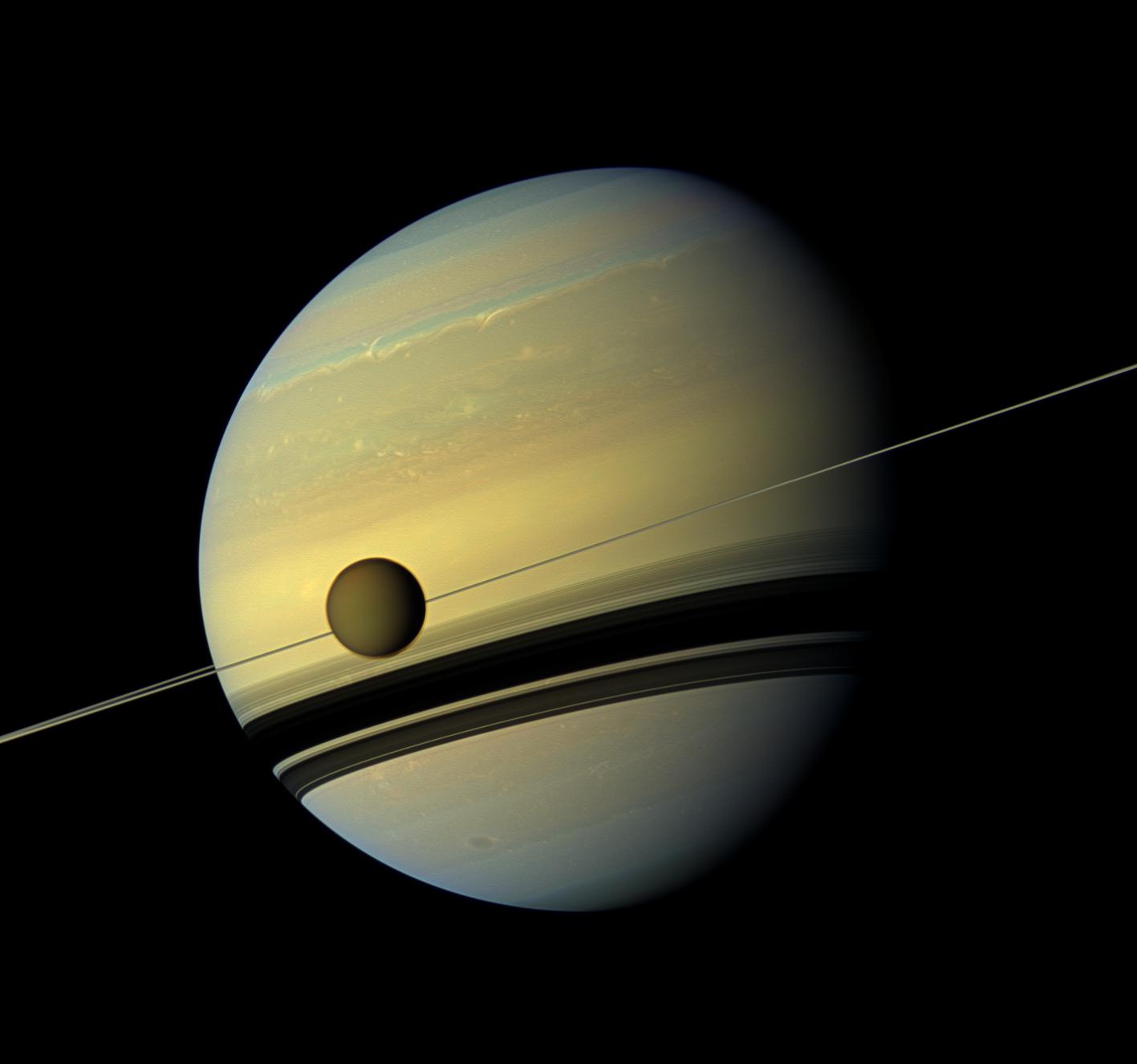
The mosaic above represents a natural color view of Saturn and Titan obtained with the Wide-Angle Camera of the Cassini probe on May 6, 2012 at a distance of about 483,000 miles or 778,000 kilometers from Titan. The mosaic is based on six views, two each of red, green and blue spectral filters. The Orange Moon is moving, here, in front of the Gas Giant. The atmosphere and the surface of Titan appear to be full of hydrocarbons or organics. Image Credit: NASA/JPL-Caltech/SSI.
- To get further information on that news, go to: http://www.astrobio.net/pressrelease/5690/titan-provides-insights-into-evolution-of-life-on-earth.
August 30, 2013: Gravity Data Gathered from Cassini Suggest a Rigid and Weathered Ice Shell Above a Subsurface Ocean on Titan
Researchers continue to gather significant clues regarding the internal structure of Saturn's largest moon, Titan. Is Titan differentiated or is it relatively uniform in its internal structure ?
Scientists hypothesize that there may be several layers of different materials in the interior of the Orange Moon. Titan is believed to be composed of a solid core of iron and nickel and of an external crust of ice covering a subsurface ocean of liquid water.
Some researchers speculate that a global subsurface ocean may be hidden beneath an outer ice shell 50 to 200 kilometers thick on the basis of Cassini data. Yet, a thin rigid shell had been proposed to account for the observed topography.
A new study led by planetary scientists Douglas Hemingway and Francis Nimmo at the University of California, Santa Cruz, published in the journal Nature on August 28 and entitled "A rigid and weathered ice shell on Titan" leads to the conclusion that Titan may be composed of a rigid ice shell covering a subsurface ocean and that there may be large ice roots below the crust where there are elevated terrains, hills or mountains.
The researchers of the study were astonished to observe that gravity tends to appear weaker where there are elevated terrains, hills or mountains. Douglas Hemingway and his team put forward a strong inverse correlation between gravity and topography at long wavelengths that are not dominated by tidal effects and the forces of rotation.
It seems paradoxical to observe that the gravity in the areas where there are mountains appears lower than the gravity in the areas which are lower in elevation because the mountains, the hills or the elevated terrains are supposed to represent an extra-mass to a relatively uniform interior. The more the mass, the higher the gravity is.
In reality, the mass beneath the top of the hills or mountains may tend to be lower than the mass below the lower terrain. This surprising observation pushes researchers into advancing the hypothesis of large ice "roots" extending into an underlying ocean of water below the hills or mountains.
Francis Nimmo, a Cassini participating researcher pointed out: "Normally, if you fly over a mountain, you expect to see an increase in gravity due to the extra mass of the mountain."..."On Titan, when you fly over a mountain, the gravity gets lower. That's a very odd observation."
The potential presence of ice roots or icebergs at the boundary between the underground ocean and the external ice crust, where there are elevated terrains, mountains or hills may result in a lower mean density of the underground simply because ice is less dense than water.
At the level of the big chunk of ice, the depth of the subsurface ocean may be lower than in other places or low-land areas and the extra-mass of the hills or mountains may be more than compensated by a mass deficit, below the mountains or hills, related to the presence of the lower-density chunk of ice and to the lower depth of the subsurface ocean whose mean density is higher than that of the ice root or the chunk of ice.
The researchers of the study claim that negative gravity anomalies or mass deficits generated by crustal thickening at the base of the ice shell exceed positive gravity anomalies or mass excesses generated by the small surface topography, accounting for the inverse correlation between gravity and topography.
Douglas Hemingway and his team also believe that Titan is composed of a particularly thick and rigid external crust due to the relatively high upward pressure engendered by the hypothetical chunk of ice onto the external ice shell. Landscape distortions may result from that kind of process.
Douglas Hemingway advanced: "It's like a big beach ball under the ice sheet pushing up on it, and the only way to keep it submerged is if the ice sheet is strong." He concluded: "If large roots under the ice shell are the explanation, this means that Titan's ice shell must have a very thick rigid layer."
The researchers assume that the rigid ice shell may have an elastic thickness higher than 40 kilometers and that there may be hundreds of meters of surface erosion and deposition, on the basis of recent estimates from local features.
The hypothesis of a very rigid shell is not in harmony with the hypothesis of active ice volcanoes, convective phenomena and of a geologically active moon. Volcanoes will rather take shape on low-rigidity ice crusts which may not be the configuration encountered on Titan.
Therefore, the icy crust of Saturn's largest moon may remain static and rigid over time and the convection movements or the plate tectonics we know may not take shape in the external crust of Titan. The convection movements may occur however in the subsurface ocean.
One could claim that a rigid icy crust is more likely to generate fractures under the action of internal forces, forces of rotation and tidal forces, compared to a flexible crust. The Tiger Stripes or the polar fractures of Enceladus demonstrate that geysers of ice and water can emerge from topographic fractures under the action of tidal forces from Saturn, the other celestial bodies or the other Saturnian moons.
The researchers took into account the wavelengths that are controlled by tides and rotation and are in a position to argue that the moment of inertia of the Orange Moon may be even higher, even centrally condensed than is currently believed.
Titan appears now in the long list of moons suspected to harbor an underground ocean of water which may host life via chemosynthesis for instance. If the icy crust is really rigid and deep, it will undoubtedly be particularly complex for us, in the future, to explore the hypothetical subsurface ocean with our probes.
The diagram above, proposed by Marc Lafferre, shows that the hypothetical subsurface ocean is less deep in areas where there are mountains, hills or elevated terrains because of an underground bump of the icy crust. As a result, the gravity appears weaker on top the icy mountain, the external icy crust being less dense than the subsurface ocean.

The color view above, obtained on the basis of the Descent Imager/Spectral Radiometer of the Huygens probe on January 14, 2005, corresponds to a stereographic or fish-eye projection of the area where the Huygens probe landed, in the area of the bright Adiri and the dark Shangri-La. At that moment, the Huygens module was approximately 5 kilometers above the ground. The bright area of Adiri is made of hills or mountains sculpted by drainage channels or fractures. The gravity may be slightly weaker in those elevated areas or mountains. Image Credit: ESA/NASA/JPL/University of Arizona.
- To get further information on that news, go to: http://saturn.jpl.nasa.gov/news/cassinifeatures/feature20130828 and http://www.nature.com/nature/journal/v500/n7464/full/nature12400.html.
July 27, 2013: How Can We Explain that Lakes on Titan Appear Almost as Smooth as a Mirror ?
Where are the waves in the lakes or seas of Saturn's largest moon Titan ? The radar data obtained with the Radar Mapper of the Cassini probe since its arrival into the Saturn System in mid-2004 suggest that the polar or high-latitude lakes or seas appear almost as smooth as a mirror. In fact, there is no discernable wave action down to the millimeter scale on the basis of radar data.
The first lake or sea clearly identified on the Orange Moon was Ontario Lacus, a kidney-shaped lake or sea located in the high latitudes of the southern hemisphere. Ontario Lacus was discovered in 2005 thanks to the infrared or near-infrared data taken with the Visual and Infrared Mapping Spectrometer of the Cassini spacecraft.
At the time of this discovery, the southern hemisphere of Titan was experiencing the Summer season which came to an end in August 2009 with the Autumn Equinox. The radar data of the Ontario Lacus area clearly show river channels or drainage channels as well as variations in the depth of the lake.
The radar data have also allowed us to determine that the equatorial or tropical regions of the Opaque Moon are particularly dry. The near-infrared views of the low latitudes unveil bright areas like Xanadu and Adiri and dark areas like Shangri-La, Fensal and Aztlan. The dark areas tend to be dominated by Seif dunes or by linear and parallel dunes extending over long distances.
That's the evidence that prevailing winds can generate a significant action onto the landscape. Prevailing winds have undoubtedly sculpted the dunes found in the dark areas of the low latitudes.
The radar data demonstrate that the bodies of liquids are mostly found in the high latitudes or in the polar regions of the moon. The north polar area appears to be the dampest region with three major lakes or seas and a pleiad of rivers or islands. Kraken Mare, Ligeia Mare and Punga Mare appear to be the largest bodies of liquids in the high latitudes of the northern hemisphere.
To a certain extent, the landscape of Titan resembles the landscape of the Earth. On Titan, there are lakes, seas, rivers, islands, mountains, cloud systems, cyclones, precipitation processes, evaporation processes, dune fields or impact craters. Ice volcanoes or cryovolcanoes may also take shape on Titan.
In fact, many familiar physical processes may occur on Titan, from rainbows to snow falls and of course, the landscape is constantly eroded by winds, rainfalls, rivers or bodies of liquids.
The familiar meteorological cycle involving the water molecule is replaced on Titan by an exotic meteorological cycle involving the methane molecule. In the harsh environment of the Opaque Moon, methane can appear in its liquid form since the environmental temperature at the level of the ground is around -179 degrees Celsius, -290 degrees Fahrenheit or 94 Kelvin as the Huygens probe parachuted into the Adiri/Shangri-La region had revealed on January 14, 2005.
The ground in the low latitudes may be saturated with hydrocarbons such as methane. The ground in the Huygens landing site may be wet but not enough to have the consistency of mud. But the mud may well be found in the wet areas of the polar regions.
Scientists are wondering why the north polar lakes are so smooth without any significant waves. The Titanian winds appear to have the power to sculpt dunes but they seem too weak to engender waves in the lakes or seas of the polar regions. Are winds too weak in the north polar regions ? Or is the surprising smoothness of the lakes related to a particularly high viscosity of the liquids filling the lakes ?
A multitude of questions upon this mystery is raised. Is there a thin layer of ice above the liquid ? In that case, the area may be extremely smooth allowing ice skating for the potential Titanaut. However, ice is supposed to be highly reflective and that is not what the radar signal shows. The presumed lakes appear dark and relatively uniform in radar images.
Moreover, some drainage channels connected to the well-known lakes or seas can be clearly identified. That implies a dynamic surface for the presumed lakes or seas. There appears to be a flow of materials or liquids from the rivers to the lakes or seas.
The exact nature of the liquids is still unknown but scientists are convinced that the lakes or seas are composed of a mixture of methane and ethane. And some other hydrocarbons or compounds may also be included in the mixture. Propane, ammonia and dissolved nitrogen are in the list of candidates.
The apparent quietness or the smoothness of the lakes or seas is really surprising because the gravity is very weak, representing only 1/7th that of Earth. The weak gravity is expected to exert a lower resistance to wave motion.
Moreover, a giant ethane-cloud system, resembling a hurricane, engulfing the north polar region had been clearly identified during the Winter period in the northern hemisphere. That suggests potentially strong winds and potentially strong waves. Alex Hayes, a planetary scientist on the Cassini radar team at Cornell University is astonished by the smoothness paradox. He led a study on the subject.
Winds or breezes which blow across the surface of a liquid tend to engender waves which ripple and break. The roughness of the lake or sea can also be triggered by snowfall or rainfall. Alex Hayes asked: "Where are all the waves ?" He pointed out: "We know there is wind on Titan."..."The moon's magnificent sand dunes [prove] it."
Several hypotheses to account for the smoothness paradox are raised: The lakes may be frozen but Alex Hayes believed that it is unlikely, "because we see evidence of rainfall and surface temperatures well above the melting point of methane." The hypothesis involving mud or a tar-like substance that damps wave motion draws more attention. Alex Hayes advanced: "We can't yet rule that out."
In a study published in the July 2013 online edition of the journal Icarus, Alex Hayes and his collaborators calculated how fast Titanian wind would have to blow to stir up waves on the basis of gravity, of the low viscosity of liquid hydrocarbons, of the density of Titan's atmosphere and other factors. It appears that a walking-pace breeze of only 1 to 2 mph would be powerful enough to engender waves.
A third hypothesis involves particularly weak winds. Winds may be particularly weak during the Winter period because the air is colder and heavier preventing strong movements of waves. The Winter period in the northern hemisphere came to an end with the Equinox of August 2009 marking the beginning of Spring.
The Summer period is approaching and the solar energy reaching the area may be slowly increasing making the air lighter and engendering stronger winds. As a result, we may soon be able to identify significant waves in the north polar lakes or seas. Alex Hayes advanced: "According to [climate models], winds will pick up as we approach the Solstice in 2017 and should be strong enough for waves."
Radar reflections from wavy surfaces can provide us with numerous information. The dimension of the waves may allow us to determine the viscosity of the underlying fluid as well as the chemical composition of the liquid. The wave speed may allow us to determine the speed of the overlying winds. All that may help scientists refine the climate model of Saturn's largest moon.
Alex Hayes has the pride of "bringing oceanography to another world. All we need now," he underlines, "are some rough seas." Let's hope that the quiet lakes or seas will wake up soon and that the lakes or seas don't look like the viscous and dark fields of oil or tar found on Earth.
|
|
| The image in the upper part of the table corresponds to
an artistic view of Ligeia Mare. The radar data suggest that the lake is
surprisingly almost as smooth as a mirror. In the image in the lower
part of the table, obtained on the basis of radar data acquired with the Radar Mapper of the Cassini probe
between February 2006 and April 2007, a grey arrow has been incorporated by Marc Lafferre
to show the orientation of the virtual camera showing the lake in the
upper part of the table. Some researchers believe that significant waves
may take shape in Ligeia Mare during the next Summer season in the
northern hemisphere.
Artist's Impression, Upper Image:
© Marc Lafferre, 2013. |

The image above reveals the first reflected sunlight from a north polar lake, identified on Titan. The lakes may act as mirrors due to their smoothness or due to the absence of significant waves. This glint may reveal the presence of a particularly smooth lake in the north polar region. The image was obtained with the Visual and Infrared Mapping Spectrometer of the Cassini probe on July 8, 2009. Image Credit: NASA/JPL/University of Arizona/DLR.
- To get further information on that news, go to: http://science.nasa.gov/science-news/science-at-nasa/2013/22jul_titan or http://www.spacedaily.com/reports/Mystery_of_the_Missing_Waves_on_Titan_999.html.
June 22, 2013: Ammonia and Methanol May Act as Antifreeze Compounds for the Preservation of a Watery Internal Ocean on Titan
Some scientists believe that an internal ocean of water may hide beneath the icy crust of Saturn's largest moon Titan. But how can this liquid layer, mainly composed of water, remain liquid if the temperature drops or evolves below the freezing point of water ?
If one postulates the presence of antifreeze compounds such as ammonia or methanol within the subsurface ocean of water, water can remain liquid if the temperature is below the theoretical freezing point of water. Antifreeze will, in fact, tend to lower the freezing point of the liquid.
Ammonia and methanol may be present in the ocean or in the seas or lakes found beneath the icy shell. They may act as antifreeze ingredients and they could get trapped within ice-like cages.
Researchers recently found hints that the Opaque Moon has a subsurface ocean of water between the de-coupled icy shell and the high-pressure ice lying above the hypothetical hydrous silicate core.
Several moons in the Solar System are thought to be composed of a subsurface ocean of liquid water. The best candidates seem to be Enceladus, a bright icy moon of Saturn where geysers erupting from fractures have been found, Triton, a moon of Neptune, Europa, Ganymede and Callisto, three major moons of the Gas Giant Jupiter.
The solar energy reaching those bodies appears particularly weak but there may be an internal activity inside those moons and the hypothetical oceans of water may possess antifreeze molecules which have, by definition, the property of preventing or stifling the formation of ice when temperatures decrease below the normal freezing point of the liquid.
Scientists performed estimates upon the depth of the hypothetical underground ocean and they concluded that the subsurface ocean may be at least 55 miles or 90 kilometers deep or thick and that it may remain stable over time provided it is approximately 4 percent methanol and 1 percent ammonia.
Ammonia, a molecule that is composed of nitrogen and hydrogen with the chemical formula NH3 can act as an antifreeze. This molecule is commonly used in fertilizer and household cleaners.
Methanol, a molecule that is composed of carbon, hydrogen and oxygen with the chemical formula CH3OH can also act as an antifreeze. This compound is the simplest type of alcohol molecule. Methanol is a colorless, flammable and poisonous chemical which can lead to death when drunk or to blindness if there is a contact with the eyes.
The physical chemist John Ripmeester, at the National Research Council of Canada in Ottawa and his collaborators performed studies that suggest that ammonia could, in fact, get trapped within clathrate hydrates corresponding to ice-like lattices.
Regarding methanol, the studies led over the past 70 years, approximately, revealed that there was no clear direct evidence that methanol could get trapped within clathrates. That's why this alcohol molecule is often incorporated, in the oil industry, to keep clathrate hydrates from developing within oil and gas pipelines.
John Ripmeester pointed out: "Common knowledge said that methanol, since it behaves like antifreeze, shouldn't enter hydrate cavities." Yet, a new research released on May 21, 2013 in the journal Proceedings of the National Academy of Sciences leads to a different conclusion. Methanol could, in fact, get entrapped within clathrate hydrates.
John Ripmeester claimed: "Methanol, a material best known as an antifreeze and used to prevent hydrate formation in industry, actually is a promoter of hydrate formation at low temperatures."
The researchers led some experiments or tests involving clathrates composed of organic compounds such as tetrahydrofuran hydrate instead of clathrates made of water ice. They noticed that near the normal freezing point of water corresponding to zero degree Celsius or 32 degrees Fahrenheit, on the basis of X-ray diffraction and nuclear magnetic resonance (NMR) spectroscopy, methanol could fill in these clathrate hydrate lattices.
It appears that if the solutions are exclusively composed of water and methanol, the mixture of these ingredients can't get frozen to form clathrate hydrates. However, if one adds methane to the solution, the mixture containing water, methanol and methane can form the clathrate hydrates representing ice-like cages. That's what experiments and molecular dynamics simulations show or suggest.
John Ripmeester and his collaborators noticed that at low temperatures, methanol tends to boost the development or formation of solid clathrate hydrates rather than eliminating them. As a result, how can methanol be used to help prevent clathrate development in pipelines in the coming years or decades, especially in polar regions and in the deep ocean ?
The presence of methanol in a hypothetical subsurface ocean mostly composed of liquid water may account for the relatively high concentration of methane, ethane or other hydrocarbons identified in the high latitudes or in the polar regions of Titan. Chemical reactions involving methanol may lead to the formation of methane or ethane which can form bubbles and reach the surface via geysers or cryovolcanoes.
Methane is present, in large amounts, in the Troposphere of Titan or even in the upper atmospheric layers. Yet, methane tends to be destroyed over time, under the action of Ultraviolet light. So, an internal activity involving methanol or other hydrocarbons may explain the surprising persistence of methane in the atmosphere.
John Ripmeester argued that temperature changes may have implications for methanol-loaded clathrate hydrates which are likely to break down, releasing methanol. He concluded: "This new knowledge definitely will affect the development of new models for icy planets."
The researchers advance that clathrate hydrates can host key ingredients for the development of life and that they can favor chemical reactions between these key molecules which can evolve close to each other.
A mixture of water, ammonia and methanol may favor the development or formation of more complex molecules such as organics or amino acids. Over time, the typical lifeforms we know, based on water and carbon, may arise.
The exact nature of the hypothetical subsurface ocean on Titan is still a subject of speculation. Some scientists have suspected the presence of a subsurface ocean primarily made of methane or ethane. A subsurface ocean mainly composed of ammonia has also been hypothesized. The hypothesis for a subsurface ocean mainly composed of liquid water with antifreeze compounds such as ammonia and methanol is favored today.
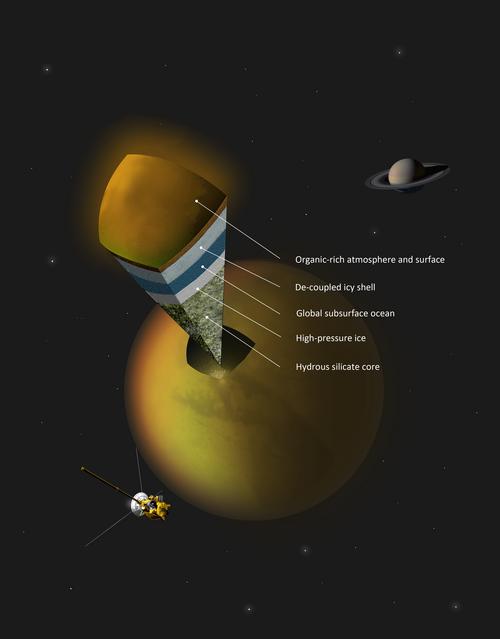
The image above corresponds to a diagram revealing the hypothetical internal structure of Titan with a subsurface ocean between the external icy shell and the high pressure ice found above the hydrous silicate core and beneath the underground ocean. This hypothetical structure is based on data from the Radio Science Experiment, from the Cassini spacecraft. Image Credit: A.Tavani.
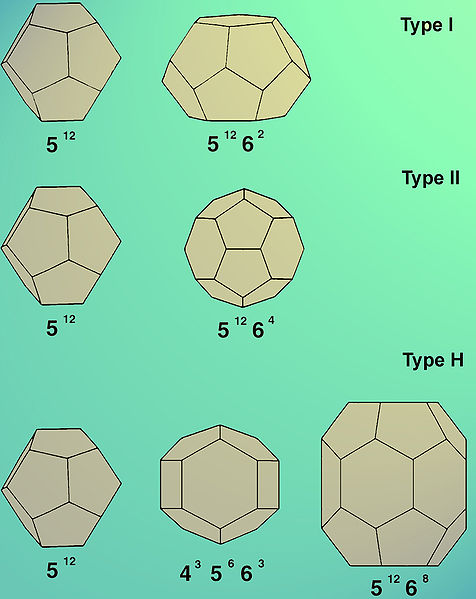
The diagram above, proposed by Georgi Genov, shows the cages forming the three gas hydrate structures. The subsurface ocean of Titan may remain liquid thanks to these types of structures involving ammonia, methanol and water. Image Credit: Georgi Genov.
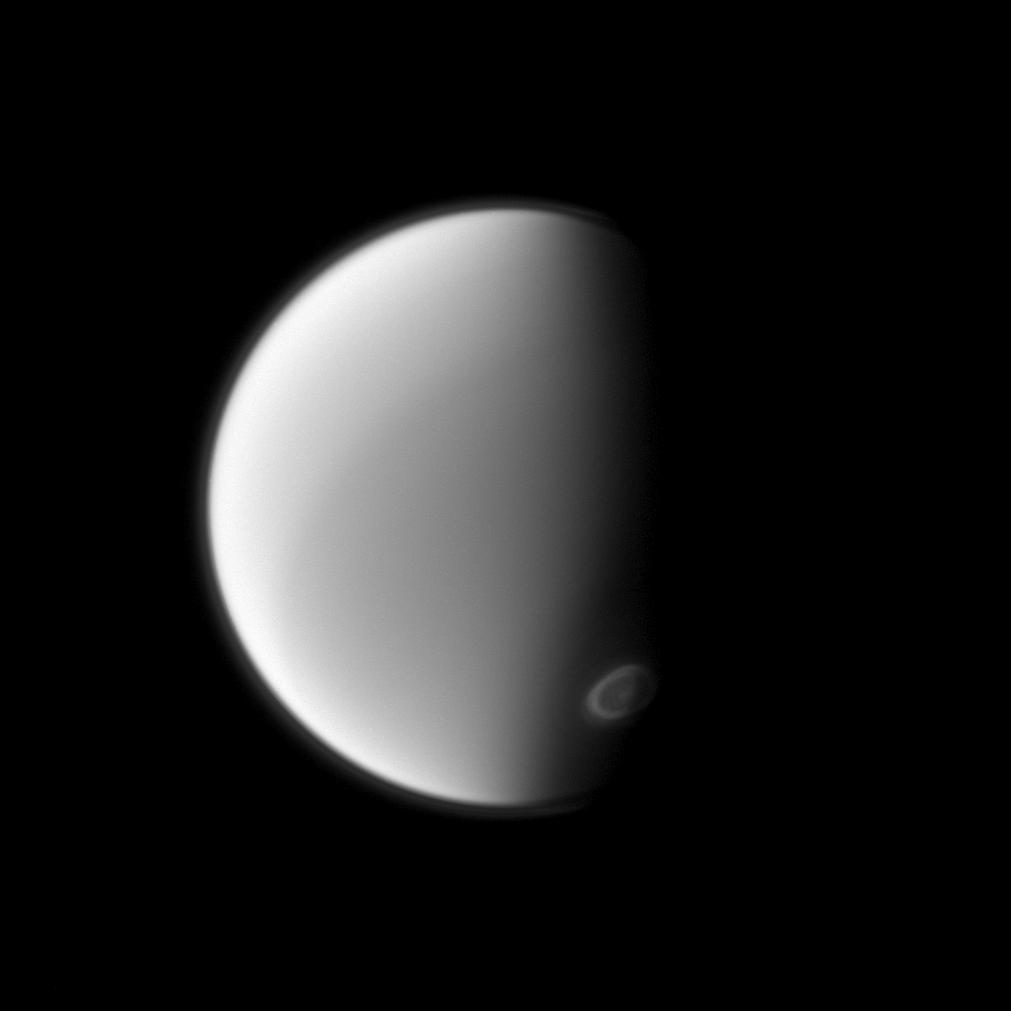
The image of Titan's disc above, acquired from the Narrow-Angle Camera of the Cassini probe on September 13, 2012 with a spectral filter sensitive to wavelengths of near-infrared radiation centered at 889 nanometers, shows a vortex developing above the south polar region, in particular. The clouds or the hydrocarbons such as methane and ethane found in the atmosphere may be linked to geysers or cryovolcanoes resulting from the pressures of an underground ocean. Image Credit: NASA/JPL-Caltech/Space Science Institute.
- To get further information on that news, go to: http://www.astrobio.net/exclusive/5527/antifreeze-on-titan-could-affect-its-chances-for-life.
June 8, 2013: Researchers Advance that the Lower-Atmosphere Haze on Titan May Result from Chemical Reactions Involving Polycyclic Aromatic Hydrocarbons Found in the Upper Atmosphere
Scientists have been in a position to identify complex hydrocarbons or complex organic compounds in the upper atmosphere of the Opaque Moon Titan. The orange-brown haze of Saturn's largest moon is made of large aerosol molecules that may result from chemical reactions involving the complex, ringed hydrocarbons or Polycyclic Aromatic Hydrocarbons (PAHs) taking shape in the upper atmosphere.
Researchers believe that the Polycyclic Aromatic Hydrocarbons forming in the upper atmosphere fall and aggregate into larger molecules that produce the haze of the lower atmosphere.
The deep, thick and opaque atmosphere of Titan is particularly complex in its structure and composition. Several detached haze layers have been identified in the upper atmosphere. The Titanian atmosphere resembles the atmosphere of the Earth in terms of composition. Both atmospheres are mainly composed of molecular nitrogen.
Oxygen and water which are particularly abundant in the atmosphere of the Earth are only present in very small amounts in the atmosphere of Titan. The second most abundant molecule in the Titanian atmosphere is methane. Methane represents approximately 2% of the atmospheric composition but methane is more abundant near the ground.
Researchers believe that Titan is a prebiotic laboratory and that it is very similar to the atmosphere of the Early Earth. There may be a methane cycle between the underground, the ground and the atmosphere on Titan with evaporation processes, cloud formations and precipitation processes.
Scott Edgington, Cassini deputy project scientist based at NASA's Jet Propulsion Laboratory, Pasadena, California advanced: "With the huge amount of methane in its atmosphere, Titan smog is like L.A. smog on steroids."..."These new papers using Cassini data shed light on how the heavy, complex hydrocarbon molecules that make up Titan's smog came to form out of the simpler molecules in the atmosphere. Now that they have been identified, the longevity of Cassini's mission will make it possible to study their variation with Titan seasons."
The methane molecules and the nitrogen molecules of the upper atmosphere, above approximately 600 miles or 1000 kilometers tend to be broken up under the action of sunlight and the highly energetic particles from Saturn's magnetic bubble. Ultraviolet light from the Sun may play a key role, in particular, in the chemistry of the upper atmosphere since methane molecules tend to be destroyed over time with the resulting molecules or particles recombining and forming new molecules such as C2H2, C2H4 or HCN.
The incoming radiations from our star engender massive positive ions as well as electrons which then fall toward the ground. The particles or molecules tend to connect to other particles or molecules during their fall, generating various hydrocarbons.
Some complex hydrocarbons have already been identified in the Titanian atmosphere. Some Polycyclic Aromatic Hydrocarbons (PAHs) can take shape at a high altitude. PAHs correspond to carbon-based molecules made of several carbon rings and forming from the aggregation of smaller hydrocarbons.
Well below the altitude of 500 kilometers or 300 miles, in the lower layers of the Titanian haze, aerosols take shape on the basis of the falling organics or PAHs. The aerosols found at this altitude are based on carbon atoms and they form larger molecules than the PAHs forming at higher altitudes.
The process of aerosol formation on Titan is reminiscent of the aerosol formation process on Earth where sunlight breaks up hydrocarbons that are expelled into the air to form the smog via the chemical reactions involving the resulting molecules or particles which tend to connect to each other.
Hydrocarbons or organics which combine to form larger and heavier molecules mechanically tend to fall toward the ground where the air is denser. The denser air favors the development of larger molecules such as complex carbon-based aerosols which are found in the lower layers of the haze, well below approximately 300 miles or 500 kilometers.
The aerosols of the low-altitude haze had been analyzed as soon as 2005 when the Huygens probe plunged into Titan's atmosphere with its various instruments. However, scientists didn't understand well the mechanisms by which those aerosols took shape.
New analyses based on data from the Visual and Infrared Mapping Spectrometer of the Cassini probe obtained in July and August 2007 help us understand the chemical reactions in the atmosphere, the formation of the Polycyclic Aromatic Hydrocarbons and the formation of the haze in the lower atmosphere.
A study of Titan's atmosphere entitled "Large abundances of Polycyclic Aromatic Hydrocarbons in Titan's upper atmosphere" and published in the Astrophysical Journal describes the identification of the Polycyclic Aromatic Hydrocarbons or PAHs which are complex molecules made of carbon rings. Those molecules form via the aggregation of smaller hydrocarbons.
The lead author of the paper, Manuel Lopez-Puertas, from the Astrophysics Institute of Andalucia in Granada, Spain argued: "We can finally confirm that PAHs play a major role in the production of Titan's lower haze, and that the chemical reactions leading to the formation of the haze start high up in the atmosphere." He added: "This finding is surprising: we had long suspected that PAHs and aerosols were linked in Titan's atmosphere, but didn't expect we could prove this with current instruments."
The researchers had performed an in-depth study of the emission from several molecules in the Titanian atmosphere. They noted that one of the characteristic lines in the spectrum from methane emissions had a slightly unusual shape leading them to suggest it was hiding something.
Bianca Maria Dinelli from the Institute of Atmospheric Sciences and Climate (part of the National Research Council) in Bologna, Italy who was the lead author of a paper entitled "An unidentified emission in Titan's upper atmosphere" and published in the journal Geophysical Research Letters led a study with her collaborators to identify the molecules responsable for the anomaly. The team observed that the particular signal only occured during daytime suggesting it was related to sunlight.
Bianca Maria Dinelli advanced: "The central wavelength of this signal, about 3.28 microns, is typical for aromatic compounds -hydrocarbon molecules in which the carbon atoms are bound in ring-like structures."
The scientists of the study performed a test to see whether the unidentified emission could be engendered by benzene, the simplest aromatic hydrocarbon consisting of only one ring, whose chemical formula is C6H6 but due to the relatively low abundances of benzene in the atmosphere, it is not consistent with the hypothesis that the unidentified emission is produced by benzene.
The researchers had the idea that the unidentified emission could be produced by Polycyclic Aromatic Hydrocarbons. As a result, they tried to obtain the observed signal with the more complex PAHs. They confronted their data with the NASA Ames PAH Infrared Spectral Data Base. They eventually managed to obtain the same emission with a mixture of several different PAHs, which are made of an average of 34 carbon atoms and about 10 rings each.
Alberto Adriani, a co-author of the study, from the Institute for Space Astrophysics and Planetology at Italy's National Institute for Astrophysics (INAF) in Rome, who is part of the Cassini-VIMS co-investigators team, who began this investigation and who manages the team that gathered and processed VIMS data explained: "PAHs are very efficient in absorbing ultraviolet radiation from the sun, redistributing the energy within the molecule and finally emitting it at infrared wavelengths."
Polycyclic Aromatic Hydrocarbons have the particularity of generating large amounts of infrared light even in a low-density environment such as that of the upper atmosphere of the Opaque Moon, where molecules don't collide very frequently with each other.
In fact, PAHs can take shape thanks to cosmic or solar radiations which tend to ionize the molecules of the upper atmosphere. The ionized particles or molecules will then react with other molecules to form new molecules or the larger molecules formed will mechanically tend to fall leading to the development of larger molecules or complex organics which will form the lower-atmosphere haze.
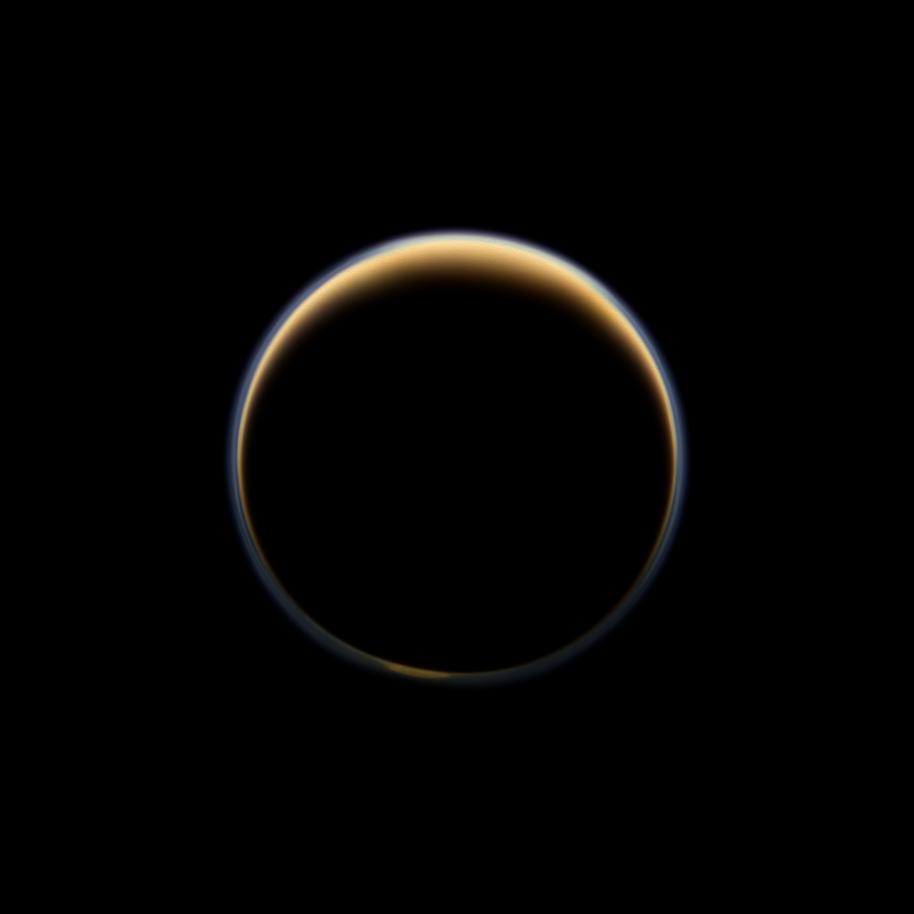
The natural color view of Titan's disc above, obtained on June 6, 2012 on the basis of the ISS Wide-Angle Camera of the Cassini probe at a distance of about 134,000 miles or 216,000 kilometers from the Opaque Moon shows the blue tint of the upper layer of the deep and thick atmosphere. North is up and inclined by 9 degrees to the right and the camera is orientated toward the Saturn-facing side of the Orange moon. One can notice the north polar hood at the top of the image as well as the yellow or brownish vortex taking shape in the south polar region. The solar radiation or the Ultraviolet light may play a key role in the formation of the Titanian haze. Image Credit: NASA/JPL-Caltech/SSI.
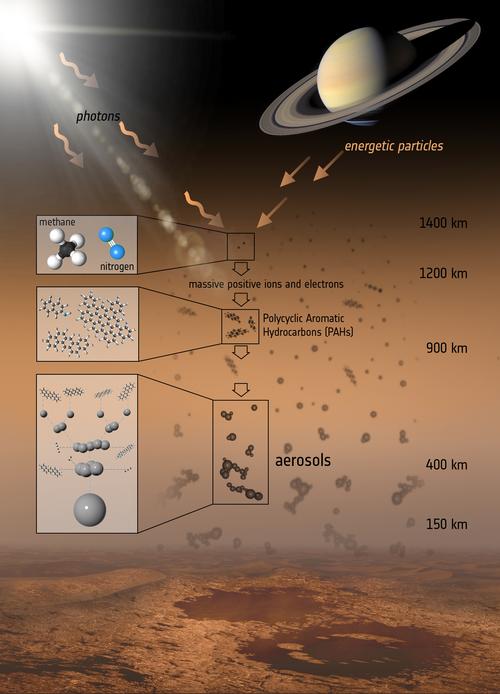
The diagram above accounts for the mechanisms by which the Polycyclic Aromatic Hydrocarbons as well as the low-altitude aerosols take shape in the atmosphere of Saturn's largest moon. The solar radiation as well as the energetic particles from Saturn's magnetic field penetrate into the atmosphere and interact with the particles or molecules of Titan's upper atmosphere to engender massive positive ions and electrons which then fall and recombine or interact to form more complex molecules and in particular Polycyclic Aromatic Hydrocarbons (PAHs). The molecules tend to sink or fall and they can interact to form even more complex molecules which form a haze in the lower atmosphere of Titan. Image Credit: ESA/ATG medialab.
- To get further information on that news, go to: http://saturn.jpl.nasa.gov/news/cassinifeatures/feature20130605 and http://sci.esa.int/science-e/www/object/index.cfm?fobjectid=51863.
May 23, 2013: Two New Models Predict the Development of North Polar Hurricanes and Waves in the North Polar Lakes or Seas During the Next Summer Season
As on Earth, the dynamics of Titanian Lakes ans Seas may change over time, depending on seasonal changes, seasonal phenomena or cloud system dynamics. Ontario Lacus, the first lake or sea identified on Saturn's largest moon and the largest body of surface liquids in the south polar region of the Opaque Moon seems to be particularly calm and flat as some analyses based on radar and VIMS data had suggested.
That's surprising because the dark areas of the low latitudes are dominated by Seif Dunes sculpted by prevailing winds which engender linear and parallel dunes extending over long distances.
Is the relative stability in the dynamics of Ontario Lacus related to seasonal factors or is it related to a high level of viscosity of the liquid ? Nobody really knows yet. The exact nature of the liquid is still unknown even if scientists believe the pools of liquids are made of a mixture of hydrocarbons such as methane, ethane and propane with traces of molecular nitrogen.
The north polar lakes may also be particularly quiet at the present time but it may soon change as the Summer period approaches. The Summer period may be accompanied by hurricanes, cyclones and relatively strong winds indeed. That may imply significant changes in the dynamics of the pools of liquids in the north polar region.
The north polar region has been imaged by the Visual and Infrared Mapping Spectrometer and by the Radar Mapper since the Cassini probe entered the Saturn System in mid-2004. We've obtained infrared or near-infrared data and radar data of the area since 2004.
The north polar region appeared in the darkness of the Winter period from 2004 to the end of the Winter period which occured in August 2009. The equinox of August 2009 which marked the beginning of the Spring season in the northern hemisphere was characterized by the fact that the light from the Sun crossed the equatorial plane.
As the Summer period approaches in the northern hemisphere, scientists anticipate that some storms will take shape in the north polar area and that the lakes or seas will generate stronger waves due to stronger winds. The potential cyclones or hurricanes may turn the north polar lakes or seas into a heaven for extraterrestrial windsurfers or sailors.
The model which predicts waves takes into account the data gathered with the instruments of the Cassini spacecraft. The models serve as a strong tool for the scientists of the mission for planning the next observations. They are in a position to determine when and where to look for seasonal atmospheric disturbances as the Summer season approaches in the region.
Scott Edgington, the Cassini's deputy project scientist at NASA's Jet Propulsion Laboratory, Pasadena, California advanced: "If you think being a weather forecaster on Earth is difficult, it can be even more challenging at Titan." He added: "We know there are weather processes similar to Earth's at work on this strange world, but differences arise due to the presence of unfamiliar liquids like methane. We can't wait for Cassini to tell us whether our forecasts are right as it continues its tour through Titan spring into the start of northern summer."
There is a high concentration of methane in the Troposphere of Titan and methane may be involved in a complex methane cycle between the lakes, seas and rivers, the underground and the atmosphere via evaporation, the development of clouds and precipitations.
The shape and the dynamics of the pools of liquids may be strongly influenced by seasonal factors. A Titanian year lasts almost 30 Earth years and a season lasts approximately 7 Terrestrial years. As a result, scientists need time to fully understand the mechanics of the climate and the weather on the Orange Moon.
By 2017, the Opaque Moon will be approaching northern solstice, the height of Summer. The Cassini mission may come to an end around 2017. The relatively high level of solar energy reaching the north polar region during that time may engender the development of storms, cyclones or hurricanes likely to make the lakes or seas very rough.
A study focusing on the potential for Titanian winds to engender waves was recently published in the journal Icarus. The research work is proposed by a team led by Alex Hayes, a member of Cassini's radar team who works at Cornell University, Ithaca, New York. The model proposed by the team aims at determining the minimum level of winds required to produce waves.
The model appears to be more accurate than the previous models since it simultaneously takes into account the gravity factor, the viscosity factor, the surface tension of the liquid of hydrocarbons likely found in the lake as well as the air-to-liquid density ratio. The relatively high atmospheric pressure on the surface appears to be a favourable factor for the development of strong waves in an environment with a low gravity.
Alex Hayes pointed out: "We now know that the wind speeds predicted during the times Cassini has observed Titan have been below the threshold necessary to generate waves." He argued: "What is exciting, however, is that the wind speeds predicted during northern spring and summer approach those necessary to generate wind waves in liquid ethane and/or methane. It may soon be possible to catch a wave in one of the solar system's most exotic locations."
The study reveals that winds of 1 to 2 mph or 2 to 3 kilometers per hour are needed to produce waves in the lakes or seas of Saturn's largest moon. Titan may be in a relatively calm period with winds which may be too weak to engender waves in the lakes or seas. But, as the amount of energy from the Sun reaching the north polar area increases as the Spring season develops and the Summer season approaches, the wind speed may progressively increase.
Waves may soon start to develop in the area. The dynamics of waves will intimately depend on the exact nature of the liquid which is still unknown. Some models predict that the winds may rise to 2 mph or 3 kilometers per hour or even faster. That may be sufficient to engender waves 0.5 foot or 0.15 meter high. But, if the lake is too viscous, the waves may not appear at all.
The model upon the potential for hurricanes on Titan, also published in Icarus, was proposed by Tetsuya Tokano of the University of Cologne, Germany. This model reveals that the warming of the northern hemisphere associated with the Spring and the Summer season is likely to engender hurricanes or tropical cyclones.
The warming of the lakes will be characterized by stronger evaporation processes and a development of clouds. The key molecule for this meteorological cycle may be methane. The Summer season may be the most propitious period for the development of hurricanes or cyclones because the surface of the lakes or seas gets warmer and the contrast between the temperature of the air and the temperature of the lakes or seas may engender disturbances in the air.
In that configuration, the humid air is likely to turn and to swirl in a counterclockwise direction over the surface of one of the northern lakes or seas. The scientists predict that the surface wind may reach the speed of about 45 mph or 70 kilometers per hour in such a storm.
Tetsuya Tokano explained: "For these hurricanes to develop at Titan, there needs to be the right mix of hydrocarbons in these seas, and we still don't know their exact composition." He concluded: "If we see hurricanes, that would be one good indicator that there is enough methane in these lakes to support this kind of activity. So far, scientists haven't yet been able to detect methane directly."
Researchers would be astonished if the Titanian hurricanes predicted in the north polar region were more powerful than the Terrestrial hurricanes observed in the tropical areas of the Atlantic Ocean on the "Blue Planet".
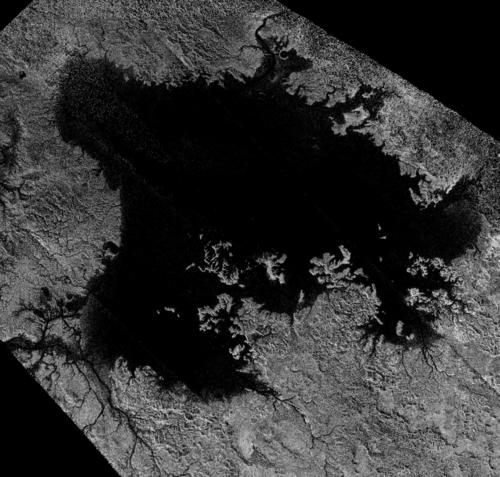
The radar mosaic above, obtained thanks to the Radar Mapper of the Cassini probe, shows the area of the giant north polar lake Ligeia Mare. This image was generated on the basis of data acquired between February 2006 and April 2007. One can notice the numerous drainage channels as well as the islands within the lake. Scientists haven't identified significant waves within the Titanian lakes yet. However, the Summer period in the northern hemisphere may be accompanied by stroms, hurricanes and strong winds likely to engender significant waves within the lakes or seas. Image Credit: NASA/JPL-Caltech/ASI/Cornell.
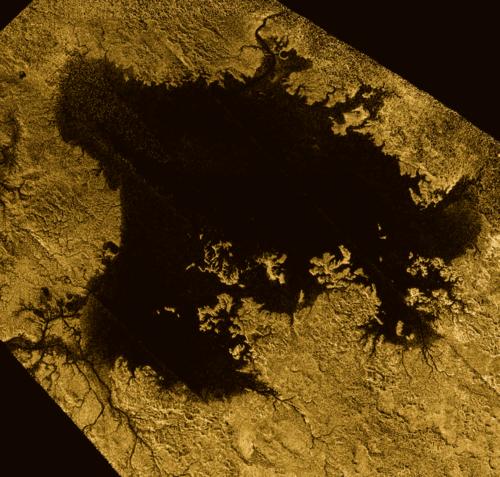
The radar image above which also unveils Ligeia Mare corresponds to a false-color view of the area. The lake which has a relatively low reflectivity or albedo appears black in this view. The area around the lake made of a solid surface appears yellow. Image Credit: NASA/JPL-Caltech/ASI/Cornell.
The artistic view above shows a hypothetical probe floating on one of Titan's largest pools of liquids in the north polar region during the Summer season. Storms, hurricanes or cyclones may be common in the high latitudes of the northern hemisphere during the Summer period. Strong waves may develop in Ligeia Mare, Punga Mare or Kraken Mare under the action of winds engendered by the cyclones or hurricanes. Artist's Impression: © Marc Lafferre, 2013.
- To get further information on that news, go to: http://saturn.jpl.nasa.gov/news/cassinifeatures/feature20130522.
May 18, 2013: Scientists Unveil the First Topographic Map of Titan Revealing Mountains and Depressions
Researchers have produced the first global topographic map of the Opaque Moon Titan. This map will serve as a powerful analyzing tool to learn more about this intriguing moon of Saturn. The topographic map is part of a paper which has been recently published in the journal Icarus.
Titan, which is the largest moon of Saturn and the second largest moon in the Solar System, appears to be a dynamic and active moon like Enceladus that produces geysers in the fractures of its south polar region.
Titan has the particularity of being covered by a thick, deep and opaque atmosphere which prevents us from discerning surface features in the visible spectrum. The atmospheric pressure on the surface of the Orange Moon is approximately 1.5 times higher than that on the surface of the Earth.
The radar data obtained with the Radar Mapper of the Cassini spacecraft have allowed us to identify lakes, seas and rivers in the high latitudes of the Opaque Moon. Cirrus-like clouds at mid-latitudes or convective cloud systems in the high latitudes or in the polar areas of the moon have been clearly observed since the arrival of the Cassini probe into the Saturn System in mid-2004.
The atmosphere of the Orange Moon is mostly composed of nitrogen like the atmosphere of the Earth. But the second most abundant gas in the atmosphere of Titan is methane. In fact, methane may be the key ingredient of a meteorological cycle comparable to the meteorological cycle of water on Earth.
In the harsh environment of Titan, there are evaporation, condensation and precipitation processes involving methane or ethane. The new map allows us to better understand the dynamics of the surface liquids. Some depressions, some basins, some pools of liquids or some rivers can be well discerned in the new maps.
A complex chemistry may take shape in the upper atmosphere of the moon, under the action of sun light. Hydrocarbon molecules such as methane or ethane break up and form new molecules such as radicals, HCN, C2H4, C2H2 or even more complex molecules which can form a haze or fall, in a similar way as snow, to the surface where they form an organic soil made of tholins or reddish compounds. Can this complex organic chemistry engender life ?
Ralph Lorenz pointed out: "Titan has so much interesting activity-like flowing liquids and moving sand dunes - but to understand these processes it's useful to know how the terrain slopes."
Ralph Lorenz who led the team who created the topographic map and who is a member of the Cassini radar team based at the Johns Hopkins University Applied Physics Laboratory, Laurel, Md. added: "It's especially helpful to those studying hydrology and modeling Titan's climate and weather, who need to know whether there is high ground or low ground driving their models."
The most useful data to study surface features on Titan appear to be radar data and near-infrared data. The VIMS instrument and the radar instrument of the Cassini spacecraft have allowed us to remove the imaging obstacle of the opaque atmosphere and to identify landscape features. The thick haze of the atmosphere scatters light in ways that make it very difficult for cameras to discern landscape shapes and shadows so that it is not possible to use the usual approach to deduce the topographic or elevation data.
During the Saturn tour of the Cassini probe which included almost 100 Titan flybys since 2004, the Radar Mapper of the Cassini spacecraft has collected crucial data on the topography and on the nature of the soil. Thus, researchers are in a position to estimate the surface height, to identify hills or mountains, basins, depressions, rivers and pools of liquids.
Steve Wall, the deputy team lead of Cassini's radar team, based at NASA's Jet Propulsion Laboratory in Pasadena, California advanced: "With this new topographic map, one of the most fascinating and dynamic worlds in our solar system now pops out in 3-D."..."On Earth, rivers, volcanoes and even weather are closely related to heights of surfaces - We're now eager to see what we can learn from them on Titan."
Unfortunately, the radar mapping process of Titan is far from being completed. The Cassini spacecraft isn't orbiting Titan, exclusively, it regularly visits other moons of the Saturn System and the Radar Mapper is not systematically used in each flyby of Titan.
Ralph Lorenz pointed out: "Cassini isn't orbiting Titan."..."We have only imaged about half of Titan's surface, and multiple 'looks' or special observations are needed to estimate the surface heights. If you divided Titan into 1-degree by 1-degree [latitude and longitude] suqares, only 11 percent of those squares have topography data in them."
The new topographic map of the Opaque Moon was created on the basis of a new mathematical process called splining. Splining is a method consisting in effectively using smooth, curved surfaces to 'join' the areas between grids of existing topographic data.
Ralph Lorenz explained: "You can take a spot where there is no data, look how close it is to the nearest data, and use various approaches of averaging and estimating to calculate your best guess."..."If you pick a point, and all the nearby points are high altitude, you'd need a special reason for thinking that point would be lower. We're mathematically papering over the gaps in our coverage."
The topographic map showing real data as well as extrapolated data reveals data which are in line with the prevailing models upon the topography and the shape of the moon. It shows or confirms, for instance, that the polar regions are "lower" than areas around the equator. The topographic articulations or interconnections allow researchers to add new layers to their study of the soil or terrain.
The dynamics of rivers or lakes can be better understood on the basis of topographic data. Researchers can model how and where the various rivers flow or they can also evaluate the dynamics of drainage channels. The distribution of pools of liquids on the globe is better understood as well. The models on the seasonal distribution of the methane rainfall can be refined as well.
Ralph Lorenz argued: "The movement of sands and the flow of liquids are influenced by slopes, and mountains can trigger cloud formation and therefore rainfall. This global product now gives modelers a convenient description of this key factor in Titan's dynamic climate system."
The topographic map is far from being perfect and accurate, simply because the radar mapping is incomplete, today and the most recent data used to generate the map were captured in 2012. By the end of the mission, probably in 2017, researchers will have the opportunity to refine the topographic map on the basis of future radar and VIMS data. Some gaps in the present coverage of the map will be filled, making the current extrapolated data of the areas useless.
Ralph Lorenz concluded: "We felt we couldn't wait and should release an interim product."..."The community has been hoping to get this for a while. I think it will stimulate a lot of interesting work."
The new map shows several mountains in the low latitudes of Titan but the tallest Titanian mountains turn out to be a lot smaller than the tallest mountains on Earth.
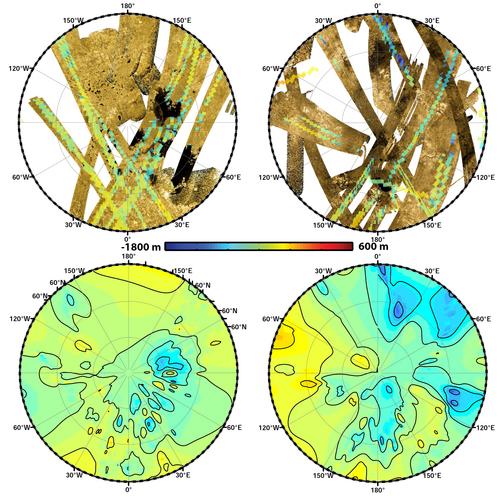
The mosaic above shows maps of the polar regions of Titan. The two views in the lower part of the mosaic represent the first global, topographic mapping of the south polar regions of the giant moon on the basis of data from the Cassini probe. The map in the lower left part of the mosaic shows the north polar region whereas the map in the lower right part of the mosaic unveils the south polar region. These maps appear in stereographic projection. The maps in the upper part of the mosaic unveil the 2-D radar data of the same region in gold and black. The map in the upper left part of the mosaic shows the north polar region whereas the map in the upper right part of the mosaic reveals the south polar region. The topographic data are color-coded by elevation, red areas being higher in elevation than blue areas. In the new maps appearing in the lower part of the mosaic, contour lines were incorporated at 656 feet (200 meters) apart in elevation. Image Credit: NASA/JPL-Caltech/ASI/JHUAPL/Cornell/Weizmann.
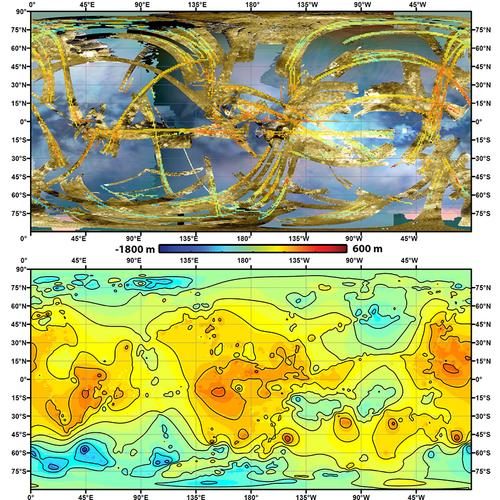
The two maps above unveil data on the nature of the surface and on the topography of the Orange Moon. The map in the upper part of the image is made of VIMS data and radar data. The radar data appear in gold and black or in yellow and black. The infrared or near-infrared portions are tinted in blue and appear in the background. The dark regions in the low latitudes tend to be dominated by sand dunes or Seif dunes. A color-coded topographic scale was incorporated into the view. The map in the lower part of the image shows the first global topographic map of Titan. Tall mountains tend to be found at low latitudes. Image Credit: NASA/JPL-Caltech/ASI/JHUAPL/Cornell/Weizmann.
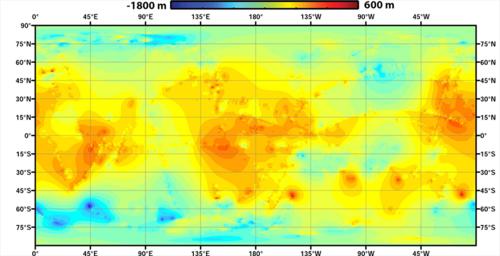
The map above corresponds to the first global topographic map of Titan on the basis of data from the Cassini probe. Some data result from mathematical models or extrapolations. A color-coded topographic scale was incorporated into the image to bring information on the altitude levels. One can notice that the depressions are mostly found in the high latitudes where the pools of liquids are concentrated. Image Credit: NASA/JPL-Caltech/ASI/JHUAPL/Cornell/Weizmann.
- To get further information on that news, go to: http://saturn.jpl.nasa.gov/news/cassinifeatures/feature20130515.
May 4, 2013: A New Study Suggests the Potential Development of Cyclones in the North Polar Region During the Summer Period
Saturn's largest moon Titan shares several similarities with our own planet. Titan is covered by a thick, dense and deep atmosphere mainly composed of molecular nitrogen. Methane appears to be the second most abundant compound in the Troposphere. This molecule may be involved in a meteorological cycle between the ground and the atmosphere.
We now know that there are lakes, seas and rivers on the surface of the Opaque Moon thanks to Radar and VIMS data acquired from the Cassini spacecraft evolving in the Saturn System since mid-2004. There are evaporation processes, precipitation processes and dynamic cloud formations similar to the cloud formations taking shape on Earth.
The meteorological cycle of Titan involves hydrocarbons.Water molecules which dominate the meteorological cycle of the Earth can't appear in their liquid form on Titan since the average temperature in the Troposphere of the Opaque Moon is close to -178 degrees Celsius, -289 degrees Fahrenheit or 95 Kelvin.
The pools of liquids are mostly concentrated in the polar areas or in the high latitudes on Titan as the radar data and the infrared or the near-infrared data have revealed. The dark areas of the low latitudes tend to be dominated by Seif dunes or parallel and linear dunes extending over long distances.
The first body of liquids identified on the surface of Titan was Ontario Lacus, a kidney-shaped lake or sea found in the high latitudes of the southern hemisphere. The finding was performed on the basis of VIMS data. Later, scientists identified large pools of liquids in the high latitudes of the northern hemisphere on the basis of radar data in particular.
Kraken Mare appears to be the largest pool of liquids in the northern hemisphere and probably the largest sea on Saturn's largest moon. Kraken Mare appears to be connected to Ligeia Mare, another major pool of liquids. Punga Mare is in the triumvirat of major pools of liquids in the northern hemisphere.
The radar images also show a pleiade of drainage channels connected to those enigmatic pools of liquids. The area may undergo erosion as on Earth and we may encounter karstic terrains and a subsurface network of rivers or seas with caves and stalagtites.
A giant ethane cloud system engulfing the north polar region had been clearly spotted from the VIMS instrument of the Cassini probe during the Winter period in the northern hemisphere.
During the Summer period in the southern hemisphere, large bright cloud systems developing in the south polar region had also been noticed in the infrared or near-infrared views. That's the sign that the area can become warm enough to engender strong evaporation processes and dynamic cloud systems producing rain.
Tetsuya Tokano, a researcher with the Institute for Geophysics and Meteorology at the University of Cologne, recently performed a study upon the potential for high speed cyclones developing on Titan. The study entitled "Are tropical cyclones possible over Titan's polar seas ?" was released in the April 2013 issue of the journal Icarus.
It seems that the north polar area may become warm enough in the summer time to produce high speed cyclones comparable to typical cyclones on Earth. The potential development of well-defined cyclones is closely related to the exact nature of the liquids present in the north polar seas or lakes. If more than half of the liquids is made of methane, the environmental conditions may be favorable to the development of cyclones, swirling masses of clouds or storms.
Under those circumstances, the evaporation process of the seas or lakes may be strong enough, under the action of sunlight and the energy it provides, to generate winds as high as 44 miles per hour or 70 km/h.
The VIMS data acquired from the Cassini probe have not yet allowed scientists to spot well-defined cyclones in the high latitudes of the giant moon but the Cassini spacecraft is expected to continue to operate until 2017 and the Summer season of the northern hemisphere starting in 2017 may be the best period to identify those hypothetical cyclones developing in the high latitudes of the northern hemisphere.
Tetsuya Tokano pointed out: "In the next few years, we will approach summer in the [northern] polar region and we might have the chance to see a cyclone, if the condition is favorable." Regarding one of the main conditions for the development of those hypothetical cyclones, he advanced: "There is big uncertainty, and many possible types of hydrocarbons."
Some scientists had argued that the lakes, seas and rivers could be mainly composed of ethane. The key molecules of the pools of liquids are probably ethane, methane and propane. Those molecules can appear in their liquid form on the surface of the Orange Moon and they can evaporate, condense and fall as rain.
The cyclone can take shape if there is enough heat, enough energy and enough moisture. Methane is more volatile than ethane and the temperature range in which it will appear as a liquid at the atmospheric pressure on the surface of Titan is narrower than that of ethane. Ethane molecules may not be sufficiently dynamic to engender cyclones on Titan.
Methane can condense like water vapor on the Blue Planet and it is the second most abundant molecule present in the Troposphere of the Saturnian moon. Tetsuya Tokano claimed: "This potentially would be large enough to make a cyclone in favorable conditions."
Cyclones on Earth can appear at several latitudes. One can discern extratropical cyclones, polar cyclones, tropical cyclones and sub-tropical cyclones. If one identifies cyclone formations on Titan one day, it may not be the cyclones that develop when cold fronts and warm fronts run into each other to form a vortex because the environmental temperature range appears too low compared to that of the Earth.
There are no clear temperature boundaries between air masses on Titan so that we won't see warm and cold air bending around each other and producing high-speed winds.
The cyclones that one may encounter on the Orange Moon may originate in strong evaporation processes from the seas or lakes. The heat from the liquids warms the air and pushes it upward generating an energy cycle that engenders high-speed winds. It then takes the shape of a vortex or a spinning storm. The right combination of moisture and temperature to generate rising air may be found above its mid-latitude seas.
The relatively high rotational axis of the Opaque Moon allows greater seasonal changes even if variations in the amount of energy received from the Sun are relatively limited. Therefore, the temperature in the north polar region may be several degrees Celsius or Kelvin higher in the Summer period than in the Winter period allowing the development of vortices or cyclones based on methane molecules.
The upcoming Summer season in the northern hemisphere may be accompanied by the formation of swirling masses of clouds or cyclones, easy to detect from the VIMS instrument of the Cassini spacecraft during its flybys scheduled between 2015 and 2017.
Tetsuya Tokano insisted on the fact that there would be "no problem to detect" cyclones on Titan since the expected huge energy transfer is likely to engender storms of at least 62 miles or 100 kilometers in diameter.
He advanced that the observation of cyclones will demonstrate temperature changes in the area between Winter and Summer. He concluded: "This would indicate Titan's weather has similarities with Earth."
Will there be net evaporation and diminishment in the size and in the level of the lakes and seas of the northern hemisphere as the Summer period advances in the northern hemisphere ? The radar data as well as the VIMS data may enable us to answer this question soon.
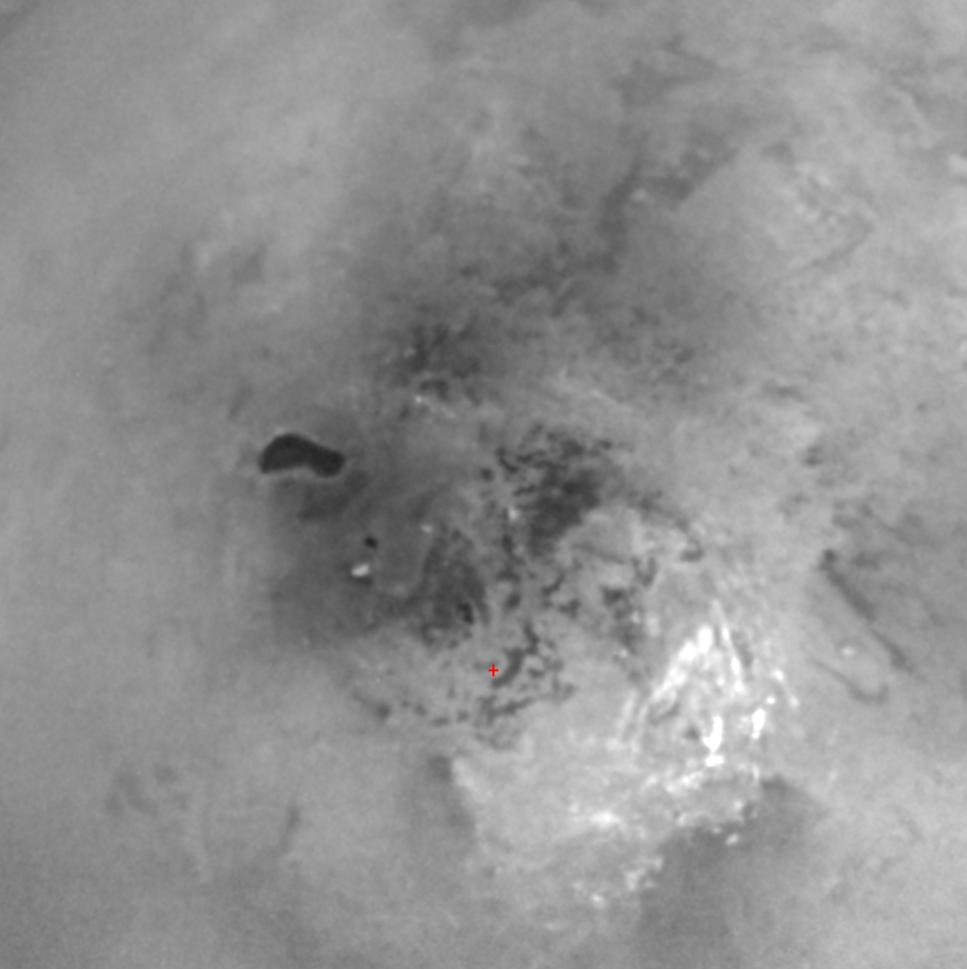
The image above corresponds to a composite of three Narrow-Angle Camera views of the south polar region obtained on June 6, 2005 at a distance of about 450,000 kilometers or 279,000 miles from Titan. The views were acquired using a combination of spectral filters sensitive to wavelengths of polarized infrared light. One can notice the dark feature of the famous lake or sea Ontario Lacus. One can also notice bright, dynamic cloud systems in the lower right part of the mosaic. This view was obtained during the Summer period in the southern hemisphere. The Summer season may be the ideal period for the development of cyclones in wetlands. Can Ontario Lacus fuel the development of cyclones or swirling masses of clouds in the area ? Image Credit: NASA/JPL/Space Science Institute.
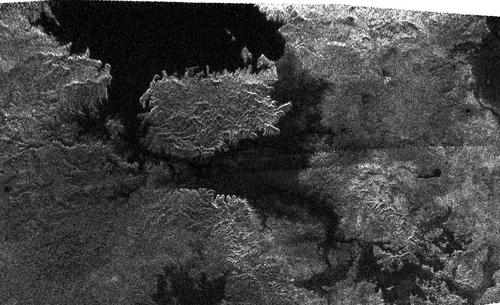
The radar image above, taken with the Radar Mapper of the Cassini probe during a near-polar flyby of Saturn's largest moon Titan on February 22, 2007 shows the region of Kraken Mare in the north polar area. North appears toward the left and the view is centered at approximately 79 degrees north and 310 degrees west. The dark uniform area corresponds to the upper part of the famous sea or lake Kraken Mare. One can also notice a bright area, about 90 kilometers or 62 miles wide and 150 kilometers or 93 miles long, surrounded by the lake or sea. This bright area corresponding to an island is now known as Mayda Insula. A giant ethane cloud system engulfing the north polar region was found a few years ago during the Winter season of the northern hemisphere. Are there strong evaporation processes from the sea or lake Kraken Mare during the Summer season in the area ? If so, can they engender the development of large cloud systems and cyclones ? Image Credit: NASA/JPL.
- To get further information on that news, go to: http://www.space.com/20304-titan-moon-seas-cyclones.html.
April 26, 2013: A New Study suggests that the Amount of Methane on Titan May Possibly Result from an Ancient Impact and that it May Be Slowly Diminishing
Since the beginning of the in-depth study of the Saturn System on the basis of the instruments of the Cassini/Huygens spacecraft in mid-2004, scientists have been in a position to determine that the distribution of clouds, lakes, seas and rivers on Saturn's largest moon is heterogenous. The infrared or near-infrared data as well as the radar data clearly show that the pools of liquids are mostly concentrated in the high latitudes of the Opaque Moon.
The first body of liquids identified on the surface of Titan was Ontario Lacus, a kidney-shaped lake located in the high latitudes of the southern hemisphere. This lake was clearly spotted on the basis of the Visual and Infrared Mapping Spectrometer which can obtain infrared or near-infrared views as well as optical views.
Scientists were surprised to notice that the low latitudes of the moon are relatively dry with transient, sporadic mid-latitude clouds whose shape is similar to Cirrus clouds observed on our planet.
The observations of the south polar region have allowed scientists to spot large, dynamic cloud systems developing during the Summer season in the southern hemisphere. The dark regions of the equatorial or tropical areas appear to be dominated by Seif Dunes or by linear and parallel dunes extending over long distances.
Researchers have also been in a position to determine, on the basis of radar data in particular, that the north polar area is the dampest region of the moon. Kraken Mare, Ligeia Mare and Punga Mare appear to be the largest pools of liquids in the high latitudes of the northern hemisphere. Those lakes may be composed of a mixture of ethane and methane.
Moreover, scientists have also been in a position to identify, on the basis of VIMS data, a giant ethane cloud system engulfing the north polar region during the Winter period in the northern hemisphere.
Scientists regularly gather radar or VIMS data of Titan's surface so that they can perform comparative analyses on the shape and appearance of landscape features on Titan. They focus their attention, in particular, on the evolution of Ontario Lacus in the south polar region and on the evolution of the pools of liquids in the north polar region.
They anticipate that seasonal changes may be accompanied by strong evaporation processes in the north polar region as the Summer season approaches and develops. By contrast, the development of the cold season in the south polar region may be characterized by strong precipitation processes.
The radar observations that may be performed during the next Winter period, if the Cassini probe is still in action, may reveal a change in the shape and an increase in the size of Ontario Lacus due to a higher level of net precipitation related to the development of the Winter season. Currently, it seems that the big lakes or seas in the north polar region are relatively or remarkably stable over time as the radar and VIMS data suggest.
On the basis of the observations, a model focusing on the supply of the hydrocarbon methane on the Orange Moon was developed by a team led by Christophe Sotin of NASA's Jet Propulsion Laboratory in Pasadena, California. This model suggests that the supply of the hydrocarbon methane may disappear soon on geological timescales.
The relative stability of the size and shape of the Titanian lakes determined on the basis of Visual and Infrared Mapping Spectrometer data from the Cassini probe over several years suggests that the lakes evaporate very slowly.
As methane is a relatively volatile molecule which tends to evaporate quickly, researchers think that the lakes may be dominated by ethane, a molecule that is less volatile than methane.
With an atmospheric pressure on the surface of almost 1.5 bars and a surface temperature close to -180 degrees Celsius, -292 degrees Fahrenheit or 93 Kelvin, the only hydrocarbons which can appear in their liquid form on the surface are methane, ethane and propane. The lakes may be composed of a mixture of these compounds. Tha abundance of ethane in the lakes or seas may be higher than that of methane and propane as the hypothesis of relatively slow evaporation processes implies.
The atmosphere of Titan is mostly composed of molecular nitrogen but methane is the second most abundant molecule in the lower atmosphere. A complex cycle of methane comparable to the cycle of water on Earth may take shape between the surface and the atmosphere. Methane on Titan can appear as rain. It can engender erosion, it can carve channels and it can evaporate. Moreover, a network of subsurface rivers or lakes can exist as well.
According to the study of Christophe Sotin and his team, the development of lakes is not particularly dynamic. Hence, the lakes are not getting filled quickly. Occasional dynamic cloud systems have been observed in the low latitudes of the moon and in the south polar region. The hydrocarbon rain may have been relatively limited. The underground reservoir of methane or ethane may be relatively limited as well so that it may be depleted soon.
Under the action of ultraviolet light from the Sun, methane molecules tend to be broken down and the elements or molecules resulting from this destruction recombine to form other molecules such as ethane.
The team of Christophe Sotin suggests that the current amount of methane is the outcome of an ancient gigantic outburst following a huge impact. Methane may have almost disappeared in tens of millions of years.
Researchers have been able to determine that the north polar lakes Kraken Mare and Ligeia Mare are connected by drainage channels as the VIMS data obtained in June 2010 show.
Scientists have also noticed, on the basis of radar images obtained in April 2007 and of a VIMS mosaic acquired in June 2010, three new lakes dubbed Freeman (VimsNN1), Cardiel (VimsNN2) and VimsNN4. The lakes appear relatively stable over time as these images show. A small lake dubbed Towada (VimsNN3) which had been observed in radar views was also observed in the VIMS data.
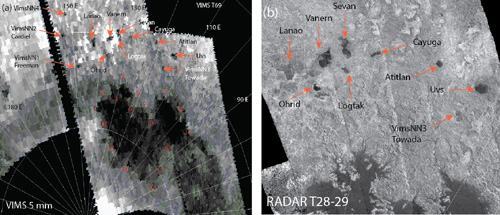
The mosaic above reveals the area of Ligeia Mare and Kraken Mare in the north polar region. The left view is based on VIMS images obtained in June 2010 whereas the right view is composed of radar images acquired in April 2007 from the Radar Mapper of the Cassini probe. One can notice the relative stability in the appearance of the lakes over time. Image Credit: NASA/JPL-Caltech/University of Arizona.
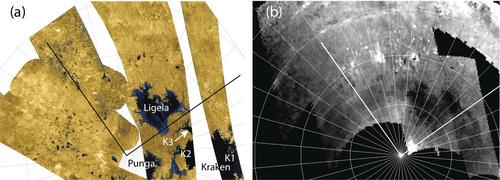
The mosaic above unveils the area of Punga Mare, Ligeia Mare and Kraken Mare. The left view, which shows the north polar region of the Orange Moon, is based on radar images obtained from the Radar Mapper of the Cassini probe. The right view shows the same area taken with the Visual and Infrared Mapping Spectrometer of the Cassini spacecraft. Both images allow us to determine for instance that Kraken Mare and Ligeia Mare are interconnected via drainage channels. Image Credit: NASA/JPL-Caltech/University of Arizona.
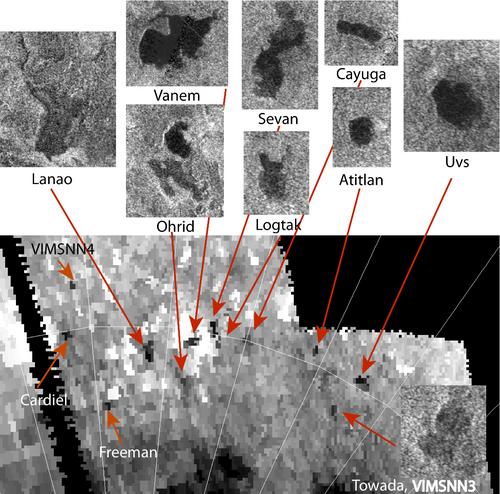
The mosaic above unveils the myriad of little lakes found in the area of Ligeia Mare and Kraken Mare. The large view in the lower part of the mosaic corresponds to a VIMS image of the area. The images in the insets correspond to radar views of the corresponding lakes in the VIMS image. Cardiel, Freeman and VIMSNN4 correspond to new lakes identified in the area. Towada, another lake found in the area, had already been spotted in the radar images of the area. The VIMS views were acquired in 2010 whereas the radar views were captured in 2007. Image Credit: NASA/JPL-Caltech/University of Arizona.
|
|
| The artistic view in the upper part of this table
shows an aerial view from a bay in a north polar lake of Titan. This
lake is now known as Vanern. The image in the lower part of the table
unveils a radar image of the lakes Vanern, Logtak and Sevan, obtained
from the Radar Mapper of the Cassini probe in April 2007. The grey arrow
incorporated into the original radar view of the area indicates the
orientation of the virtual camera which generated the artistic image
above, based on the "Shape From Shading" technique. Original Radar Image Credit:
NASA/JPL-Caltech/University of Arizona. |
- To get further information on that news, go to: http://saturn.jpl.nasa.gov/news/cassinifeatures/feature20130415.
April 13, 2013: The Development of a Mysterious Ice Cloud in the South Pole Accompanies the Development of the Autumn Season in the Area
Saturn's largest moon Titan unveils a relatively dynamic atmosphere with the development of sporadic high-latitude cloud systems, strong winds, evaporation and precipitation processes despite the relatively little amount of energy the moon receives from our star.
Shortly after the arrival of the Cassini spacecraft in the Saturn System in mid-2004, a giant ethane cloud system engulfing the north polar region was clearly identified in the infrared or near-infrared spectrum. At the time, the northern hemisphere was experiencing the Winter season as opposed to the southern hemisphere which was experiencing the Summer season.
The Huygens probe which landed into the low latitudes of the southern hemisphere into the Adiri/Shangri-La area unveiled bright hills with dark, sinuous channels and an apparently arid landscape. Subsequent observations with the Radar Mapper or with the Visual and Infrared Mapping Spectrometer of the probe showed that the wet areas tend to be concentrated in the high latitudes or in the polar areas of the moon.
The dark low-latitude areas of the moon turn out to be dominated by Seif Dunes or by linear and parallel dunes extending over long distances. That's the sign that the low-latitude regions have been relatively dry over the past few years.
During the Summer season in the southern hemisphere, multiple sporadic and dynamic cloud systems were spotted over the south polar region or in the high latitudes of the southern hemisphere. The first lake or sea identified on Titan, known as Ontario Lacus, was identified in the high latitudes of the southern hemisphere.
The Summer season of the southern hemisphere came to an end in August 2009. The Autumn Equinox of August 2009 marked the start of the Autumn season in the southern hemisphere and the beginning of the Spring season in the northern hemisphere. A Titanian season is particularly long. It lasts approximately 7.5 Earth years and a Titanian year is almost 30 Earth years long.
The seasonal changes seem to have strong implications for the dynamics of the atmosphere and for the methane/ethane cycle as Cassini observations tend to suggest.
A yellowish vortex developing over the south polar region was clearly identified from the Cassini probe as soon as July 2012. This swirling mass of gas may be the sign of radical changes in the area. The multiple observations seem to show that this vortex is not weakening over time and we may think that it will continue to grow as the Winter season approaches and develops in the area.
By contrast, the giant ethane cloud system which had been observed over the north polar region during the Winter period seems to be fading now as the Spring season in the area advances and as the observations from the Composite Infrared Spectrometer (CIRS) suggest. The north polar cloud may continue to fade as the Summer period approaches and develops, in particular, because of the higher amount of solar energy it will receive. The nature of the ice cloud which has been developing over the south polar region is still unknown.
Donald E. Jennings, a CIRS Co-Investigator at NASA's Goddard Space Flight Center in Greenbelt, Md and the lead author of the study upon the ice cloud published in Astrophysical Journal Letters in December 2012 pointed out: "We associate this particular kind of ice cloud with winter weather on Titan, and this is the first time we have detected it anywhere but the north pole."
The southern ice cloud which can be observed in the far infrared part of the spectrum is a clear sign of a radical change in the pattern of global air circulation which seems to have reversed direction.
On the basis of the first observations performed from the Cassini probe, scientists were in a position to infer that warm air from the southern hemisphere was rising high in the atmosphere and that it then traveled toward the cold north pole. During its travel toward the north pole, the air cooled and sank down to lower atmospheric layers forming ice clouds.
This process is reminiscent of atmospheric processes on Earth such as the process of the Hadley Cell. This well-known process is characterized by the rise of warm, moist air from the Tropics which travels to the cooler middle latitudes where it sinks.
The Orange Moon Titan was expected to encounter pronounced seasonal changes because the tilt of the rotation axis is higher than that of the Earth, approximately 27 degrees compared to 23.4 degrees for the Earth.
The decrease in the amount of solar radiation reaching the south polar region due to the development of the Autumn season was expected to engender the development of a cloud system similar to the cloud system previously observed over the north polar region during the Winter period but researchers didn't know exactly when the phenomenon would take shape and how fast it would develop.
The first signs of the atmospheric or weather reversal were noticed in early 2012. In mid-2012, a natural color view of the south polar region unveiled a yellowish vortex or a mass of swirling gas developing over the area.
The Visual and Infrared Mapping Spectrometer data showed the presence of a high-altitude "haze hood" and a kind of cyclone in the south polar region. Will it continue to grow as the Winter season approaches and develops?
The Cassini researchers have also reported that infrared observations of winds and temperatures performed by CIRS on the Opaque Moon had provided clear evidence of air sinking, rather than upwelling in the south polar area. The atmospheric change may have occured shortly after the equinox of 2009.
The ice cloud was identified as soon as July 2012, a few months after the haze and the vortex were identified in the high latitudes of the southern hemisphere as the authors of the study claim.
Carrie Anderson, a CIRS team member and Cassini participating scientist at Goddard explained: "This lag makes sense because first the new circulation pattern has to bring loads and loads of gases to the south pole. Then, the air has to sink. The ices have to condense. And the pole has to be under enough shadow to protect the vapors that condense to form those ices."
The development of the south polar ice cloud seems to be quite rapid at first sight. It will be interesting to monitor the evolution of the north polar cloud system which has been slowly fading since the arrival of the Cassini probe in the Saturn System. Will it still be present during the next Summer season in the northern hemisphere?
Scientists try to determine the nature of the ice cloud in the south polar region. This cloud may be composed of a mixture of organic compounds. Let's point out that the researchers have ruled out the fact that the cloud may be composed of simple chemicals such as methane, ethane or hydrogen cyanide.
Michael Flasar who is the CIRS Principal Investigator of Goddard argued: "What's happening at Titan's poles has some analogy to Earth and to our ozone holes."..."And on Earth, the ices in the high polar clouds aren't just window dressing: They play a role in releasing the chlorine that destroys ozone. How this affects Titan chemistry is still unknown. So it's important to learn as much as we can about this phenomenon, wherever we find it."
Besides, the Titanian atmosphere may be the place of a particularly complex chemistry or even a prebiotic chemistry. A laboratory experiment performed at NASA's Jet Propulsion Laboratory, Pasadena, California aimed at simulating the atmosphere of the Orange Moon leads to the conclusion that complex organic chemistry or that a prebiotic chemistry extends lower in the atmosphere than previously believed. The study was presented in a paper recently published in Nature Communications.
Murthy Gudipati, the lead author of the paper at JPL pointed out: "Scientists previously thought that as we got closer to the surface of Titan, the moon's atmospheric chemistry was basically inert and dull."..."Our experiment shows that's not true. The same kind of light that drives biological chemistry on Earth's surface could also drive chemistry on Titan, even though Titan receives far less light from the Sun and is much colder. Titan is not a sleeping giant in the lower atmosphere, but at least half awake in its chemical activity."
The hazy atmosphere of Titan composed of hydrocarbons such as methane and ethane may engender carbon-nitrogen-hydrogen molecules which can fall into the surface to form a brownish material that the astronomer Carl Sagan had called tholins.
Mark Allen, a co-author of the study and the principal investigator of the JPL Titan team that is a part of NASA Astrobiology Institute, headquartered at AMES Research Center, Moffett Field, California pointed out: "We've known that Titan's upper atmosphere is hospitable to the formation of complex organic molecules."..."Now we know that sunlight in the Titan lower atmosphere can kick-start more complex organic chemistry in liquids and solids rather than just in gases."
It appears that organic-ice photochemistry at conditions similar to that of Titan's lower atmosphere can generate tholins or a brownish haze as the experiment suggests. The experiment focused on dicyanoacetylene which was exposed to laser light at wavelengths as long as 355 nanometers.
Will we ever find methane-based bacteria or prebiotic molecules in the lower atmosphere of Titan? The team of the study was composed of Isabelle Couturier of the University of Provence, Marseille, France, Ronen Jacovi, a NASA postdoctoral fellow from Israel and Antti Lignell, a Finnish Academy of Science postdoctoral fellow from Helsinki at JPL.
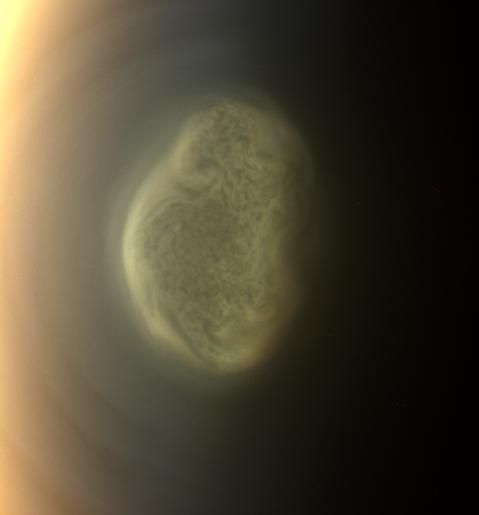
The image above reveals the south polar vortex of Saturn's largest moon, identified on June 26, 2012 from the Narrow-Angle Camera of the Cassini probe. This is a natural color view obtained on the basis of a combination of red, green and blue spectral filters. The view was acquired at a distance of about 301,000 miles or 484,000 kilometers from the Orange Moon. The development of this vortex may be intimately related to seasonal changes. The equinox marking the end of the Summer season in the southern hemisphere and the beginning of the Autumn season in the southern hemisphere occured in August 2009. Image source: NASA/JPL-Caltech/Space Science Institute.
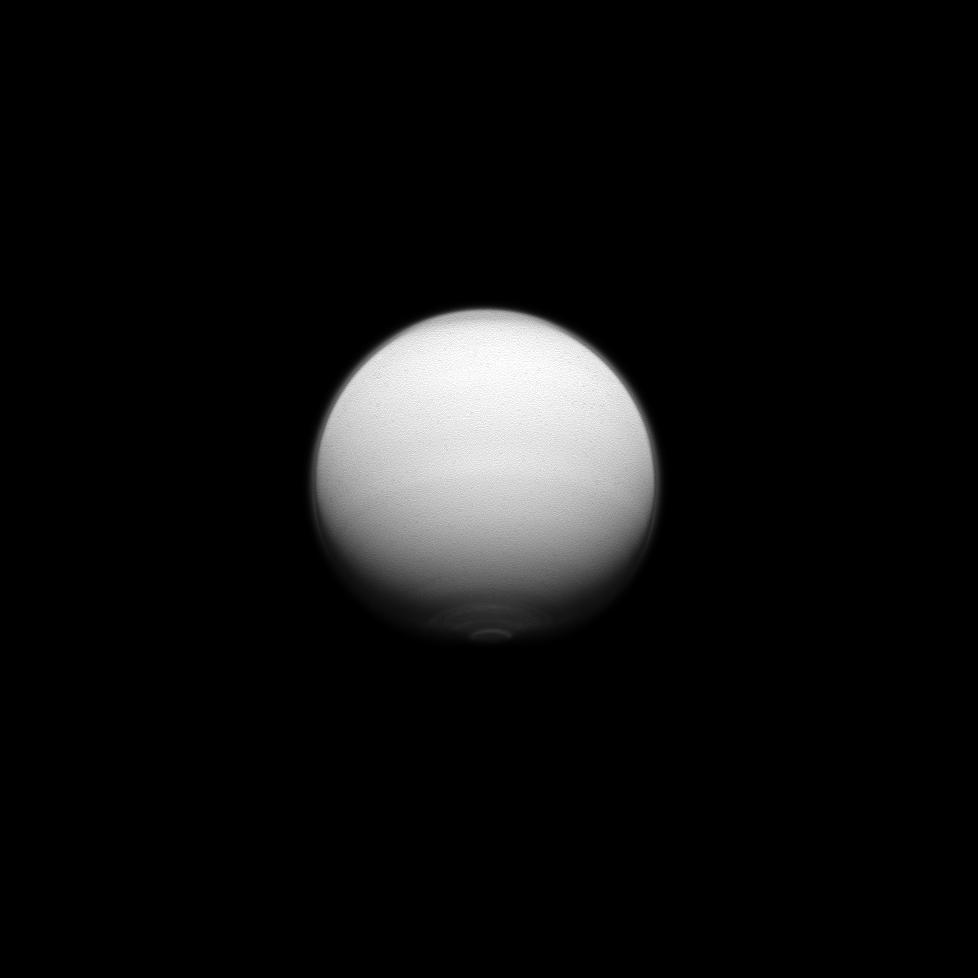
The image above corresponds to a violet light image of the Titanian disc obtained with the Wide-Angle Camera of the Cassini spacecraft on July 25, 2012 at a distance of about 175,000 miles or 281,000 kilometers from the Orange Moon and at a Sun-Titan-probe, or phase, angle of 37 degrees. On can observe the varied atmosphere of the second largest moon in the Solar System. The dark cap of the north polar hood can be well discerned here. The bright south polar vortex can be clearly noticed as well. The upper haze layer can also be observed. Image source: NASA/JPL-Caltech/Space Science Institute.
- To get further information on that news, go to: http://saturn.jpl.nasa.gov/news/cassinifeatures/feature20130411 and http://spaceref.com/saturn/complex-chemistry-at-titan.html.
February 6, 2013: A New Study Clearly Describes the Formation of Haze From the Upper Atmosphere of Titan
One of the most surprising characteristics of Saturn's largest moon Titan is the presence of a deep, thick and opaque atmosphere which completely prevents us from observing the surface from outer space in the visible spectrum.
Titan appears as an orange disc in the natural color views taken from the Visual and Infrared Mapping Spectrometer of the Cassini probe. The opacity of the atmosphere is related to complex photochemical processes which engender a haze or a smog.
The ultraviolet light from the Sun plays a key role in the break-up of aerosols, organics or hydrocarbons. Some molecules are being destroyed by solar radiations in the upper atmosphere but the new molecules or particles recombine to form new molecules such as radicals, hydrogen cyanide, acetylene or even more complex molecules.
Titan appears to have a dynamic atmosphere with different layers of gas and complex tropospheric phenomena such as cloud formations, evaporation processes and precipitation processes. There is a meteorology on the Orange Moon and this meteorology involves a methane or ethane cycle between the ground and the lower atmosphere.
Seasonal factors seem to play a key role in the distribution of clouds over the globe. The seas, the lakes and the rivers appear to be mostly concentrated in the high latitudes or in the polar areas of the moon.
The equatorial or tropical areas seem to be relatively dry as the radar views or the near-infrared images suggest. The dark areas of the low latitudes appear to be dominated by sand dunes, Seif dunes or linear and parallel dunes extending over long distances. Those observations show that the low latitudes of the Opaque Moon are relatively dry at the present time.
A new study clearly describes the mechanisms by which the haze or the smog is being generated in the atmosphere of the second largest moon in the Solar System. The study is presented in a paper released this week in the Proceedings of the National Academy of Sciences. The paper, entitled "Aerosol growth in Titan's ionosphere", was led by Panayotis Lavvas, a Cassini participating researcher based at the University of Reims, Champagne-Ardenne, France.
Roger V. Yelle, Tommi Koskinen, Axel Bazin, Véronique Vuitton, Erik Vigren, Marina Galand, Anne Wellbrock , Andrew J. Coates, Jan-Erik Wahlund, Frank J. Crary and Darci Snowden also participated in the study.
The origin of the haze may be found in the upper atmosphere of Titan, where the ultraviolet light from our star interacts with molecules of nitrogen and methane to engender new molecules, from simple molecules to complex molecules. Thus, the reddish-brown smog seems to begin in the ionosphere, a portion of the atmosphere composed of negative and positive ions.
The organic molecules or the hydrocarbons such as methane, ethane, propane, acetylene or ethylene will collide with the ions engendering, via that collisional process, bigger and more complex molecules. The heavier molecules will tend to fall toward the surface. In the lower atmosphere, this "lego game" occurs as well with aerosols interacting, connecting to each other or coagulating with neutral particles.
The Seif dunes observed in the low latitudes of the Orange Moon may find their origin in the complex haze of the atmosphere which produces various organics including complex organic molecules that reach a mass limit allowing them to fall into the surface to form dunes, mud or tholins.
A complex seasonal cycle of methane and ethane can be observed between the ground and relatively low altitudes. If one can admit that bright clouds take shape via evaporation and condensation processes, one could also imagine that methane or ethane molecules emanating from the break-up and the recombination of molecules may account for the development of clouds in the complex atmosphere of Saturn's largest moon.
The team of Panayotis Lavvas based the research on Cassini data from the Plasma Spectrometer, the Ion and Neutral Mass Spectrometer and the Radio and Plasma Wave Science Experiment. The results found by the group of scientists were compared to those obtained by the Huygens probe of ESA during its atmospheric plunge of Titan at the beginning of 2005 and it turns out that they were compatible.
A better understanding of the aerosol formation in the atmosphere of Titan may help us predict the behavior of smoggy aerosol layers on our planet. It will be interesting to study the formation and the development of the vortex or cyclone recently identified over the south polar region. Is the development of the vortex related to the seasonal variation in the intensity of solar radiation, to the level of photochemical processes or to condensation processes ?
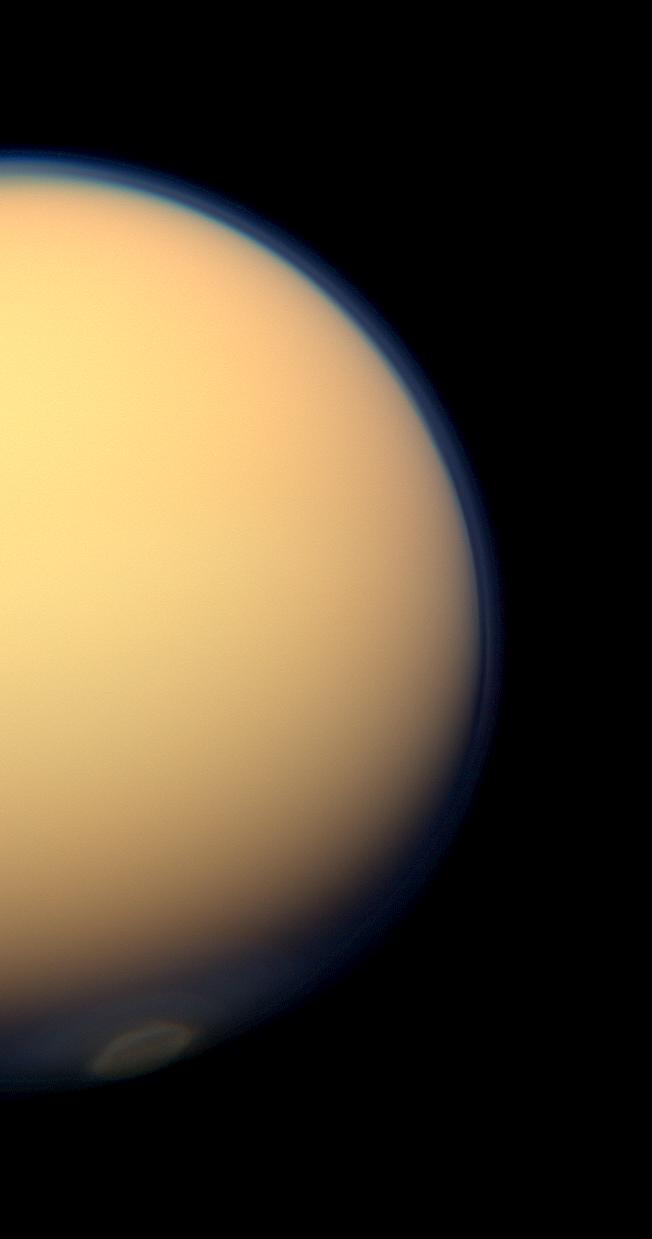
The natural color view above, taken by the Wide-Angle Camera of the Cassini probe on July 25, 2012 shows a portion of the disc of the Opaque Moon Titan. The image was captured at a distance of about 64,000 miles or 103,000 kilometers from Saturn's largest moon. One can notice, in particular, the upper layers of the deep and dense atmosphere. The upper limits of the atmosphere appear with a blue tint. One can observe a yellowish vortex in the atmosphere of the south polar region as well. This mass of swirling gas may continue to develop as the Winter season approaches in the southern hemisphere. The emergence of this cyclone may be related, indeed, to a decrease in the incoming energy from the Sun which favors condensation phenomena. Image Credit: NASA/JPL-Caltech/SSI.
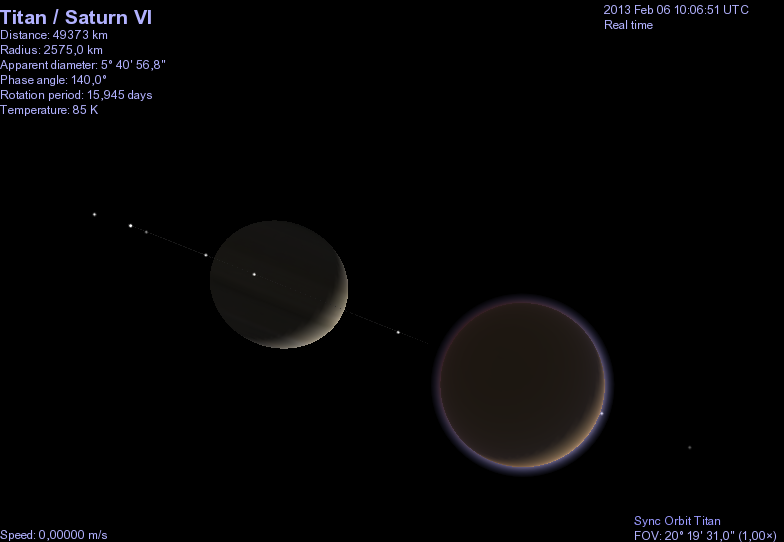 |
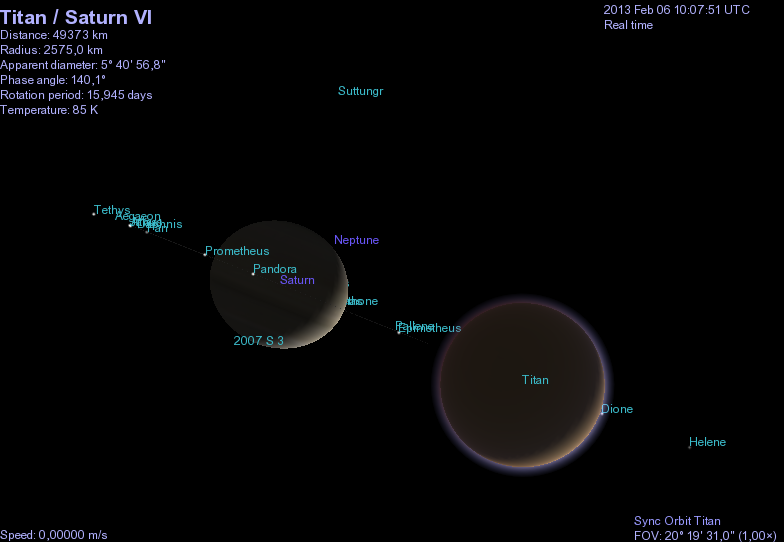 |
| The image in the upper part of the table which is a simulated view generated with the software Celestia shows the Opaque Moon Titan as it would appear from the eye of the viewer on February 6, 2013. On can observe Saturn on the horizon as well as several moons of the Gas Giant. The texture of Titan's atmosphere, in this view, was created by Marc Lafferre. The image in the lower part of the table corresponds to the same view with the names of the main celestial bodies present in the area of Saturn included. |
- To get further information on that news, go to: http://saturn.jpl.nasa.gov/news/cassinifeatures/feature20130204 and http://intl.pnas.org/content/early/2013/02/01/1217059110.abstract.
January 19, 2013: A New Analysis of Titan's Craters Shows the Potential Erosional Action of Wind-Blown Hydrocarbon Sand
Over time, the multiple moons of Saturn have been bombarded by comets or meteorites. Some icy moons like Mimas, Tethys, Dione or Rhea clearly show today a multitude of impact craters. Some craters can disappear over time under the action of cryovolcanic events or internal activities.
If the south polar region of Enceladus doesn't show any clear impact craters, it may be related to the geysers of icy particles or to the cryovolcanoes found in the "Tiger Stripes" of the south polar region.
The identification of craters appears harder for Saturn's largest moon Titan simply because there is a thick and opaque atmosphere covering the globe which prevents us from directly observing the surface from any spacecraft in the visible spectrum.
Moreover, the Titanian atmosphere involves a meteorology with evaporation and precipitation processes and winds. These meteorological phenomena are likely to play a key role in the evolution of the shape of craters via erosional processes.
The infrared or near-infrared data as well as the radar data obtained from the Cassini spacecraft since its arrival into the Saturn System in 2004 have allowed scientists to spot a surprisingly limited amount of craters on the surface of the Orange Moon. One can claim that craters on Titan are relatively scarce compared to the other major Saturnian moons.
The surface of Titan may not be as young as it is believed because the ancient craters can be completely erased over time by the movement of sands or dunes. Dunes of hydrocarbon may be progressively filling in some craters according to a new research based on data gathered by the Cassini probe.
Catherine Neish, a Cassini radar team associate based at NASA's Goddard Space Flight Center, Greenbelt, Maryland and the lead author of a paper upon this study entitled "Crater topography on Titan: Implication for landscape evolution" and published online in the journal Icarus on December 3, 2012 pointed out: "Most of the Saturnian satellites - Titan siblings - have thousands ans thousands of craters on their surface. So far on Titan, of the 50 percent of the surface that we've seen in high resolution, we've only found about 60 craters."
Numerous craters may not be visible from space because of the erosional processes they have undergone. One of the elements that scientists use to estimate the age of a planet's surface is the mean number of craters per surface area. Older terrain will tend to unveil more craters than recent terrain.
However, this technique can be misleading because strong erosional processes engendered by winds, rain, rivers or lava flows can erase ancient surfaces. As a result, researchers could underestimate the age of a surface. Catherine Neish asserted: "This research is the first quantitative estimate of how much the weather on Titan has modified its surface."
The meteorology of the Opaque Moon shows some similarities to the meteorological cycle on Earth. But in the harsh environment of Titan, we'll not find liquid water and the meteorological cycle will involve rains of liquid ethane or liquid methane. Rainfall may progressively erase the original shape of craters.
Catherine Neish and her collaborators performed a comparative analysis of craters on Titan and craters on Ganymede, Jupiter's largest moon. Scientists assume that the surface of Titan and the surface of Ganymede are relatively similar. The external crusts of both moons may be mostly composed of water ice.
The big difference between the two moons is related to the atmospheric factor. Ganymede has almost no atmosphere whereas Titan has a significant atmosphere. Therefore, the craters of Ganymede can't be degraded by winds or rain as opposed to the craters of Titan. One may expect deeper craters on Ganymede with sharper boundaries or edges.
Catherine Neish explained: "We found that craters on Titan were on average hundreds of yards [meters] shallower than similarly sized craters on Ganymede, suggesting that some process on Titan is filling its craters."
The team of Catherine Neish based the comparative analysis on the depth-versus-diameter indicator. Regarding the analysis of craters on Ganymede, the team used the stereo images obtained from NASA's Galileo probe. The same indicator for Titanian craters was calculated on the basis of estimates of the crater depth from views acquired from the radar instrument of the Cassini spacecraft.
The relatively limited amount of craters on Titan may also be related to internal activities and to the existence of pockets, seas or oceans of liquid ethane or methane beneath the icy crust.
The origin of the methane observed in the Titanian atmosphere remains a mystery because methane molecules tend to be destroyed over time in the upper atmosphere of Titan due to the action of ultraviolet light.
A complex chemistry of hydrocarbons and organics seems to occur in the upper atmosphere of Titan as the observations suggest. Methane molecules combine with other molecules to form more complex hydrocarbons in the upper atmosphere and a thick, orange smog that makes the atmosphere opaque takes shape. Some organic molecules which become sufficiently heavy fall into the surface and form a sand of hydrocarbons.
Catherine Neish argued: "Since the sand appears to be produced from the atmospheric methane, Titan must have had methane in its atmosphere for at least several hundred million years in order to fill craters to the levels we are seeing."
Researchers postulate that the current supply of methane should be broken down by solar radiations within tens of millions of years. Therefore, Titan may have had much more methane in the past or there is a replenishment mechanism that remains to be determined. An hypothetical subsurface ocean of methane or ethane may account for the large amount of methane present in the atmosphere today.
The flow of liquid methane and liquid ethane may be partially responsible for the erosion observed in some craters. Windblown sand of hydrocarbons may also play a key role in modifying the topography of the craters.
The liquids tend to fill a crater quickly at first but once the crater rim is less steep or more curved, the liquids have a weaker erosional action. That's why there are not only partially filled craters on Saturn's largest moon.
Catherine Neish underlines: "Instead we see craters at all stages; some just beginning to be filled in, some halfway, and some that are almost completely full. This suggests a process like windblown sand, which fills craters and other features at a steady rate."
The nature of the liquids that are likely to fill in some craters on Titan must be precisely determined to get a better estimate of the age of the craters studied. What is the degree of viscosity of the liquid ? If the flow is particularly viscous, the liquid will flow very slowly and it will take a longer time for the liquid to fill in the crater and a shallow crater will be in fact older than expected.
Due to the extremely low environmental temperature on Titan, the flow of ice shouldn't be very strong and the large difference in depth between the Titanian craters and the Ganymede craters can't be explained exclusively by the ice flows.
The Radar Mapper of the Cassini spacecraft has unveiled about 50 percent of the ground of Titan until now. The craters analyzed by the team of Catherine Neish are all found within approximately 30 degrees of the equator, a relatively dry region of the moon, dominated by Seif dunes or linear and parallel dunes in the dark equatorial or tropical areas.
Degraded craters can also be explained by the humidity level of the soil in which the craters took shape. If the hypothetical meteorite crashes into the ground of a region made of a subsurface reservoir of liquid methane or ethane, the crater will not be well defined as opposed to a crater in a dry area.
Catherine Neish argued: "However, the presence of liquids on the surface and in the near subsurface can also cause extensive modification to crater shape, as is observed on Earth."..."In the case of Titan, liquids consist of hydrocarbons, either as wet sediments (such as those observed at the Huygens landing site) or shallow marine environments (such as the lakes observed at the north and south poles). Craters formed in similar environments on Earth lack any significant surface topography, including the absence of a raised rim, as wet sediments slump into the crater. It is possible that the lack of topography associated with marine-target impacts may help to explain the relative scarcity of impact craters observed near the poles of Titan. If Titan's polar regions are saturated by liquid hydrocarbons, craters formed in those regions may lack any recognizable topographic expression."
The most significant erosional factor for the evolution of the shape of the Titanian craters studied by the team of Catherine Neish may well be windblown sand of hydrocarbon but liquids of various viscosities are also likely to play key roles in erosional processes of the low-latitude craters.
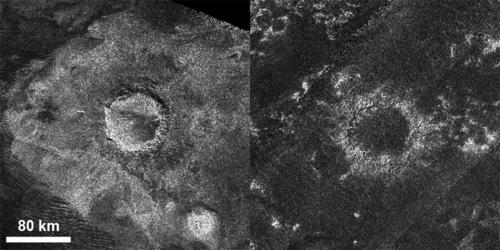
The mosaic above reveals radar images of two circular landscape features on Titan, believed to represent impact craters. The left view obtained on February 15, 2005 with the Radar Mapper of the Cassini spacecraft shows Sinlap, a well defined crater with relatively sharp rims or edges. The right view constructed from two images of the Cassini spacecraft taken on May 21, 2009 and July 22, 2006 shows Soi, a circular landscape feature which seems highly eroded and invaded by windblown hydrocarbon sand. Image Credit: NASA/JPL-Caltech/ASI/GSFC.
|
|
| The panorama in the upper part of the table corresponds
to an artist's impression of Sinlap, a well-known crater located on
Saturn's largest moon Titan. At first sight, Sinlap seems to be a
relatively recent impact crater since its boundaries are well defined
and not particularly eroded. The artistic view was generated by Marc
Lafferre on the basis of the "Shape from Shading" technique.
In the view of the lower part of the table which shows the Sinlap area,
a grey
arrow was incorporated by Marc Lafferre into the original radar image taken on February 15, 2005
to show the orientation of the
virtual camera unveiling the artist's impression. Original Radar Image Credit:
NASA/JPL-Caltech/ASI/GSFC. |
- To get further information on that news, go to: http://saturn.jpl.nasa.gov/news/cassinifeatures/feature20130117.
January 12, 2013: Hydrocarbon Ice Floating on Titan's Lakes and Seas ? A New Study Puts Forward the Hypothesis for Floating Hydrocarbon Ice
Some radar images obtained from the Cassini probe since its arrival into the Saturn System have clearly shown that the high northern and southern latitudes of Saturn's largest Moon Titan are covered with lakes, seas and rivers.
The surface of the giant moon can't be observed from the probe in the visible spectrum because of the deep, thick and opaque atmosphere of Titan. That's why the radar instrument of the Cassini spacecraft is particularly usefull. It allows scientists to perform an in-depth analysis of the topography of the moon. Scientists can also combine infrared or near-infrared data with radar data to study the composition of the soil.
Some radar signatures are associated with the presence of lakes, seas or rivers. That's the case if an area appears uniformly dark or poorly reflective. Scientists have clearly identified lakes, seas and rivers in the high latitudes of the northern hemisphere and in the high latitudes of the southern hemisphere. The largest concentration of liquid bodies can be found in the high latitudes of the northern hemisphere.
Kraken Mare, Ligeia Mare and Punga Mare appear to be the largest pools of liquids in the high latitudes of the northern hemisphere. Ontario Lacus, which was the first pool of liquids clearly spotted on the Orange Moon, appears to be the largest body of liquids in the high latitudes of the southern hemisphere.
A new study involving Jason Hofgartner, a Natural Sciences and Engineering Research Council of Canada scholar at Cornell and Jonathan Lunine, a Cassini interdisciplinary Titan scientist at Cornell University, Ithaca, N.Y. suggests the possibility of blocks of hydrocarbon ice floating on the lakes or seas of liquid hydrocarbon.
Some clues upon the presence of floating ice may appear in some radar views of the presumed bodies of liquids. A radar image acquired on May 22, 2012 from the Radar Mapper of the Cassini spacecraft reveals some lakes in the high northern latitudes with a certain degree of roughness or smoothness or with different levels of brightness or reflectivity.
If the lake is composed of floating ice, it may unveil bright dots or patches within a relatively dark and uniform area. Some lakes showing a relatively high reflectivity may be composed of mud or may be completely evaporated lakes as the radar image of May 22, 2012 suggests.
Jonathan Lunine pointed out: "One of the most intriguing questions about these lakes and seas is whether they might host an exotic form of life."..."And the formation of floating hydrocarbon ice will provide an opportunity for interesting chemistry along the boundary between liquid and solid, a boundary that may have been important in the origin of terrestrial life."
The exact nature of the liquid on the surface and of the presumed ice floating on the lakes, seas or rivers remains to be determined. Scientists know that the atmospheric pressure on the surface is around 1.5 bars and that the environmental temperature on the surface is around -179 degrees Celsius, -290 degrees Fahrenheit or 94 Kelvin. The Huygens probe which landed into the Shangri-La/Adiri region on January 14, 2005 recorded that level of temperature on the ground and an atmospheric pressure on the surface of 1,467 hPa.
These environmental parameters are consistent with the potential presence of lakes, seas or rivers of liquid methane, liquid ethane or even liquid propane. It's likely that the typical pool of liquids on Titan is composed of a mixture of ethane and methane with traces of molecular nitrogen. Any block of ice floating on a Titanian lake would have a mean density lower than the mean density of the liquid on which it floats.
Seasonal changes may account for significant changes in the level or in the appearance of the lakes, seas or rivers. Titan appears to be, to our knowledge, the only extraterrestrial body in the Solar System to harbor stable surface liquids.
There is a hydrological cycle on Titan involving methane and ethane. The hydrological cycle of methane and ethane shows some striking similarities with the hydrological cycle of water on the "Blue Planet". This exotic cycle implies evaporation processes, precipitation processes as well as condensation processes.
The observation of a dichotomy in the distribution of pools of liquids between the north polar region or the high latitudes of the northern hemisphere and the south polar region or the high latitudes of the southern hemisphere may imply that the evaporation processes or the precipitation processes related to seasons are strong.
The volume of surface liquid in the polar regions may be higher during the Winter period than during the Summer period. The radar images of Ontario Lacus, the big lake or sea of the southern hemisphere, clearly show that Ontario Lacus is the remnant of a bigger sea which has partially evaporated. A parallel can be drawn with the Aral Sea. Some north polar lakes appear to be dried-up lakes as well suggesting strong evaporation processes.
Titan appears to harbor a complex organic chemistry, both in its atmosphere under the action of ultraviolet light and on the ground with the formation of tholins or organic compounds. The presumed ice blocks made of hydrocarbons and floating on the lakes, seas or rivers may be composed with complex organic molecules or even with the building blocks of life.
Liquid methane and liquid ethane may act as a solvent for the development of an exotic form of life involving carbon, methane and ethane. The debate for this exobiological hypothesis is more open than ever.
Liquid water is dense than water ice. That's why water ice floats on liquid water. However, this particular characteristic of water can't be applied to methane because liquid methane is less dense than solid methane. Therefore, blocks of pure solid methane couldn't float on pure liquid methane.
A new model taking into account the interactions between the lakes and the atmosphere studies the potential materials capable of floating on the liquid bodies of the Orange Moon. The scientists of the study envisage different compositions or mixtures of compounds within the presumed ice blocks floating on the liquid bodies. The amount of air or nitrogen gas within the ice blocks and the temperature variations will play a key role for the development of floating ice.
Winter ice will tend to float on the methane-and-ethane-rich lakes or seas if the temperature is beneath the freezing point of methane which is at around minus 297 degrees Fahrenheit, 90.4 Kelvins (-182.75 degrees Celsius). The researchers analyzed different types of ice, composed of at least 5 percent "air" and capable of floating on the liquid bodies of Titan.
This particular concentration of air corresponds to an average composition for young sea ice on our planet. However, the Titanian air is richer in nitrogen than the air of the Earth. The concentration of atmospheric nitrogen near the ground is at around 94% of the overall composition of the air whereas molecular nitrogen represents roughly 78% of the composition of the air on Earth.
A slight decrease in the temperature on Titan may engender a decrease in the volume of nitrogen gas within the ice blocks. As a result, the ice blocks may become denser than the liquid, they couldn't float anymore and they would sink.
If the temperatures are close to the freezing point of methane, one may encounter, at the same time, floating ice and sinking ice. It will in fact depend on the exact composition of the ice which is likely mainly composed of hydrocarbons. The researchers advance that the floating ice on Titan may be colorless but they are not sure about it. The light from the atmosphere may make it reddish-brown to the observer.
Jason Hofgartner argued: "We now know it's possible to get methane-and-ethane-rich ice freezing over on Titan in thin blocks that congeal together as it gets colder - similar to what we see with Arctic sea ice at the onset of winter."..."We'll want to take these conditions into consideration if we ever decide to explore the Titan surface some day."
The next radar images of the Titanian lakes may bring new clues on the potential presence of blocks of hydrocarbon within the lakes, seas or rivers on the basis of the observation of reflectivity changes or phenomena within the liquid bodies. Scientists anticipate that as the Spring season advances in the northern hemisphere and the temperature increases, the lakes or seas may become more reflective as ice rises to the surface due to a decrease in its density.
In that case, the lakes or seas may appear less dark, less smooth or more reflective in the radar views. As the Summer season approaches, the floating ice may start to disappear due to the increase in temperatures. In that case, the surface of the liquid body would be pure liquid and the lake or sea would appear more uniform and darker in the radar images.
Linda Spilker, a Cassini project scientist at NASA's Jet Propulsion Laboratory, Pasadena, California advanced:" Cassini's extended stay in the Saturn system gives us an unprecedented opportunity to watch the effects of seasonal change at Titan." She concluded: "We'll have an opportunity to see if the theories are right."
Will we start to observe strong evaporation processes in the north polar region as the Summer season approaches and develops in the coming years ? If so, the presumed ice blocks floating on the north polar lakes or seas may progressively disappear.
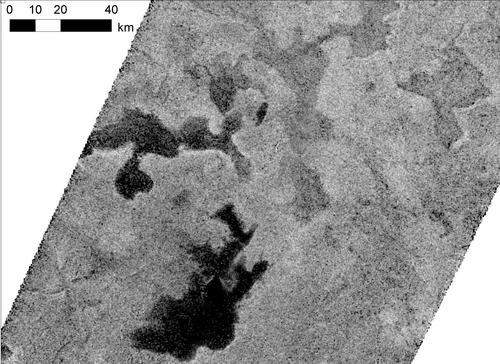
The radar view above, taken with the Radar Mapper of the Cassini probe on May 22, 2012 unveils relatively dark and uniform areas likely corresponding to lakes of liquid hydrocarbons such as methane and ethane. Those lakes are situated in the high latitudes of the northern hemisphere. In the upper right portion of the image, one can notice two uniform areas showing a relatively high reflectivity. They may correspond to dried-up lakes or they may be composed of mud. The lake in the upper left part of the image seems to be relatively shallow and it may be covered with icebergs or blocks of hydrocarbon ice as the bright dots or patches suggest. Image Credit: NASA/JPL-Caltech/ASI/Cornell.
|
|
| The artist's impression in the upper part of the table
corresponds to a computer-generated image of one of the north polar
lakes imaged with the Radar Mapper of the Cassini spacecraft on May 22,
2012. The radar portion shown in the lower part of the table corresponds
to the lake represented in the upper part of the table. The grey arrow
incorporated by Marc Lafferre into the original radar view shows the
orientation of the virtual camera from which the artist's impression was
generated. One can clearly notice ice blocks floating on the lake in the
artist's impression. Original Radar Image Credit:
NASA/JPL-Caltech/ASI/Cornell. |
- To get further information on that news, go to: http://saturn.jpl.nasa.gov/news/cassinifeatures/feature20130108.
Titan
News 2012
Titan
News 2011
Titan
News 2010
Titan
News 2009
Titan News 2008
Titan
News 2007
Titan
News 2006
Titan News
2004, 2005
